NEW ZEALAND - AUSTRALIA 2019
|
 |
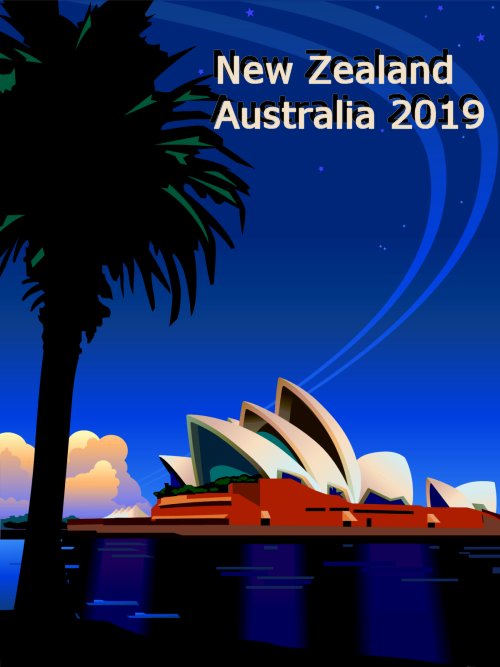 |
2019
New Zealand Australia Itinerary
|
|
March 08: Day
01
|
Friday |
Sydney,
Australia |
|
March 09: Day
02
|
Saturday |
cruising
to New Zealand |
|
March 10: Day
03
|
Sunday |
cruising
to New Zealand |
|
March 11: Day
04 |
Monday |
New Zealand:
Milford Sound, Doubtful Sound, Dusky Sound |
|
March 12: Day
05
|
Tuesday |
Dunedin,
New Zealand |
|
March 13: Day
06
|
Wednesday |
cruising |
|
March 14: Day
07
|
Thursday |
Wellington, New Zealand |
|
March 15: Day
08
|
Friday |
Napier, New
Zealand |
|
March 16: Day
09
|
Saturday |
Tauranga,
New Zealand |
|
March 17: Day
10
|
Sunday |
Auckland,
New Zealand |
|
March 18: Day
11 |
Monday |
Bay of
Islands, New Zealand |
|
March 19: Day
12 |
Tuesday |
cruising
back to Sydney |
|
March 20: Day
13 |
Wednesday |
cruising
back to Sydney |
|
March 21: Day
14 |
Thursday |
disembark
Sydney, Australia |
|
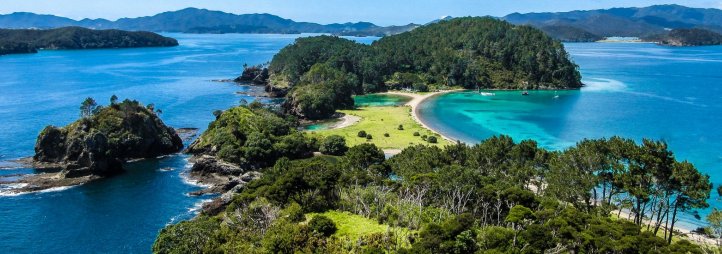 |
Cruise Pricing
(All
rates are per person double occupancy) |
|
Inside
Virtual Balcony
Category
4U, Decks 7, 8, 9 |
$1567 |
|
Balcony Category
8D
Decks
6, 7, 8, 9 |
$1948 |
|
Balcony Category
6D
Decks 10, 11, 12, 13 |
$1971 |
|
| |
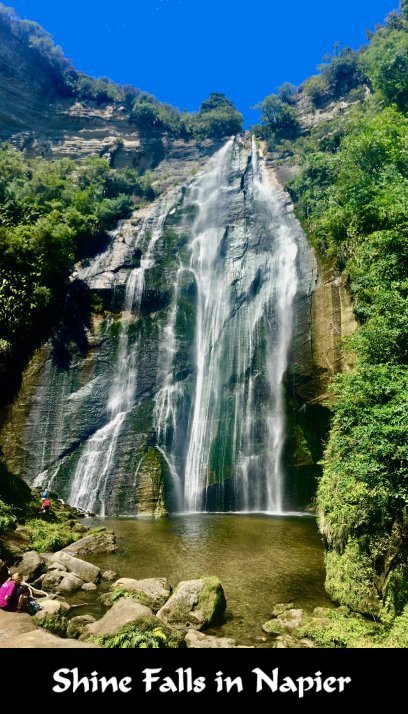 |
A Note from Marla Archer:
Dear Travel Friends,
Rick and I
invite you to join us on our long awaited trip to Australia
and New Zealand in March, 2019. We will be sailing on Royal
Caribbean's Ovation of the Seas for a 13 Night Cruise
departing Sydney, Australia on March 8 cruising to see all
the incredible sights in New Zealand and returning to Sydney
on March 21st.
Australia and New Zealand are two of the most requested
destinations. This is understandably so. As one can
see, the cruise part of our trip is mostly New Zealand with
its spectacular natural beauty. Staggering mountains,
lush waterfalls, and pristine marine preserves are among our
New Zealand destinations. If you are a nature lover, this is
the trip of a lifetime for you! This cruise is
definitely on my bucket list and I know others within our
Travel Family agree.
This is not to say we are neglecting Australia. Using
Sydney as both the embarkation and
disembarkation port, each guest has the opportunity to add a
'pre' cruise or 'post' cruise land trip to
visit Australia's interior. Now that we have traveled
this far, Rick and I definitely intend to take advantage of
this rare chance to see Australia.
Please note Australia and New Zealand are 1,200 miles apart.
This will give us four wonderful days at sea to dance and
party just as hard as we possibly can. The combination
of two incredible destinations, sailing on one of Royal
Caribbean's finest ships, the phenomenal value offered, and
great friends guarantees this trip will be equal to our
terrific 2016 Greek Isles Cruise... and maybe even
better!
This trip is so impressive that I have had 24 people sign up
before Rick even announced the trip in his Newsletter.
Please come join us and share in our adventure!
Marla Archer
A Word to
the Wise: Since I have a limited amount of
group space and my rates are considerably lower than Royal
Caribbean's prevailing rates, sign up now. If you know
this is something you want to do, be smart and take
advantage of the lower rate and get a great stateroom
location. Do not pay more unnecessarily. Nor is
there any reason to take the risk of getting shut out like
several did on our Greek Isles Cruise..
|
The Great
New Zealand Trivia Quiz
Rick Archer's Note:
One of the joys of traveling is the chance to learn some
more about areas of the world we did not know much
about. I would guess that of all locations on earth, we
know the least about Africa.
After Africa I suppose it is a toss-up between Asia and
Oceania. I bet most of you do not know a darn thing
about New Zealand. I have prepared a little quiz for
you. Let's see if you are any good.
RICK'S NEW ZEALAND TRIVIA QUIZ
1. What famous movie was filmed in New Zealand?
Lord of the Rings
Game of Thrones
South Pacific
Godzilla
King Kong
Battle of Iwo Jima
2. Which European first discovered New Zealand?
Abel Tasman
James Cook
Amerigo Vespucci
Ferdinand Magellan
Posh Spice
3. Which is closest to the Arctic Circle?
Australia
South Africa
Russia
Argentina
New Zealand
4. The first people of New Zealand were known as:
Aborigine
Zulu
Maori
Kiwi
Scottish
Polynesian
Aucklander
Martians
5. How far is New Zealand from Australia?
200 miles
800 miles
1,200 miles
2,000 miles
3,000 miles
6. New Zealand is comprised of:
600 islands
One main island
Two main islands
Three main islands
Seven main islands
7. New Zealand is closest to:
Tahiti
Galapagos
Hawaii
Philippines
Fiji
Australia
8. Which is not an island just off the coast of New
Zealand?
Chatham Island
Pitcairn Island
Stewart Island
Auckland Island
Great Barrier Island
9. The tallest mountain in New Zealand is
Mt Victoria
Mt Elizabeth
Ayers Rock
Mt Cook
Mt Krakatoa
10. The capital of New Zealand is:
Wellington
Dunedin
Auckland
Melbourne
Sydney
11. What do Norway and New Zealand have in common?
Deep oil reserves
Proximity to the Poles (no, not Poland, dummy)
Great skiing
Fjords
High Quality of Living Index
12. Which island is not a neighbor of New Zealand?
New Caledonia
Falklands
Tahiti
Samoa
Tonga
Fiji
13. Which celebrity is not from New Zealand?
Keith Urban
Russell Crowe
Lorde
Peter Jackson
Hugh Jackman
Lucy Lawless
14. New Zealand is famous for what sport?
Cricket
Soccer
Skiing
Rugby
Australian rules football
15. What is the most unusual feature of Auckland?
below sea level
located on isthmus
located on peninsula
main part developed inside extinct volcano
located on archipelago
16. What is the favorite dance of New Zealand?
The Scottish Reel
Thriller
Waltzing Matilda
Haka
Jive
17. If you sail due east from New Zealand, the next
landmass you will reach is:
Tahiti
Samoa
Indonesia
Galapagos
Argentina
Hawaii
Answers to
Rick's Trivia Quiz
|
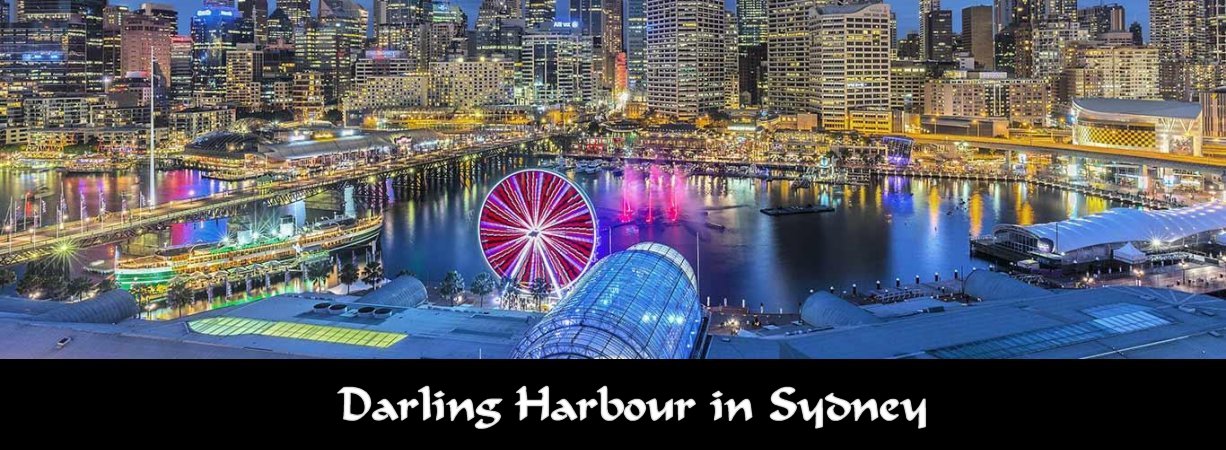 |
| |
|
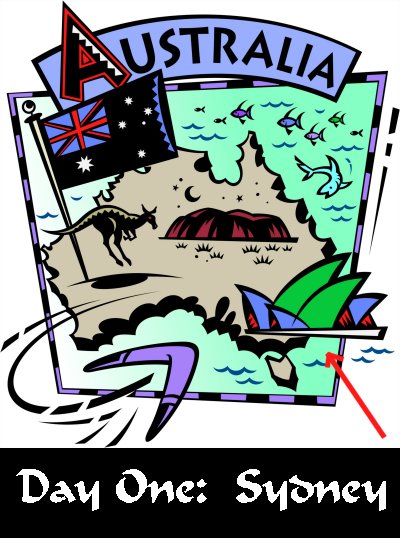 |
Sydney is the
oldest, largest, and most beautiful of all Australian
cities. In 1788, Captain Arthur Phillip, commander of
the First Fleet, established the first British colony in
Australia here at Sydney Cove. For those unfamiliar
with the history of Australia, England decided to use it as
the dumping ground for its worst convicts.
That was then,
this is now. Sydney reflects the adventurous spirit of
its early settlers to this day. As one glides along
the lovely harbor on a ferry, you can gaze with wonder at
the white sails of the Opera House and admire the graceful
arch of the Harbor Bridge. Amidst so much beauty, it
is hard to imagine this vibrant state capital was once a
brutal convict colony.
There are all
sorts of things to do at Sydney. Visitors
can explore Sydney's fabled history in the narrow cobbled
laneways and historic buildings of the Rocks. Along
the way, be sure to take a look at the city's excellent
museums. While you're at it, definitely check out the
rock paintings of the Gadigal aboriginal people who once
thrived on this land.
Visitors can
climb the harbor bridge, surf the green-barrel breaks at
Sydney's golden beaches, or fly over the city on a scenic
tour. The national parks which surround the city also
provide appealing day trip possibilities.
|
TOP TEN THINGS TO DO IN SYDNEY
1. Spend the day at the Sydney Opera House.
One of the world's great icons, the Sydney Opera House is a
UNESCO World Heritage Site and the star attraction on the
glittering harbor. This graceful building, shaped like
shells or billowing sails, perches on a finger of land
surrounded by water.
A masterpiece of architecture, the Sydney Opera House is one
of the world's most famous buildings. There are many ways
you can experience what the Sydney Opera House has to offer.
You can take a photo on the steps of the Opera House,
explore it majestic exterior and splendid interior on daily
tours, and enjoy performances held under its iconic white
sails. The Sydney Opera House in Circular Quay hosts more
than 40 performances each week.
Snap a photo while gliding by on a harbor cruise, relax at
one of the restaurants, stroll around its exterior, or take
an organized tour of this magnificent structure, which
encompasses theaters, studios, exhibition rooms, a concert
hall, and cinema.
On the edge of Sydney Harbor, one of the world's great
natural harbors, the Sydney Opera House was evaluated as
"one of the indisputable masterpieces of human creativity,
not only in the 20th century but in the history of
humankind".
The Sydney Opera House hosts 1,600 performances every year
including ballet, opera, theatre, dance, music and comedy as
well as children's shows and more. You can combine shows
with delicious food at the Opera Kitchen and Bennelong
Restaurant, or enjoy pre-show drinks at the Opera Bar.
2. Climb to the top of the Sydney Harbor Bridge
Nicknamed "The Coathanger" and dating back to 1932, the
Sydney Harbour Bridge is one of Australia's grandest
engineering feats.
The Sydney Harbour Bridge was the city's best-known landmark
prior to construction of the Opera House. Supported by
massive double piers at each end, it remains the world's
largest steel arch bridge, connecting the harbor's north and
south shores in a single curve rising 134 m above the water.
Along its length run two railway lines and eight lanes for
road traffic, the direction of which can be varied according
to traffic flow. Increasing bridge traffic encouraged
construction of a harbor tunnel in 1992 to ease congestion,
but motorists can still drive over the bridge for blue water
views. Pedestrians can stroll across on walkways or join a
guided ascent through 'Bridge Climb' for a breathtaking
panorama of the city and harbor.
Daring souls who want to climb to the 440 feet high summit
can book the Sydney Bridge Climb. This is a spectacular
opportunity that takes groups of up to 13 people on an
approximately 3.5 hour climb to the top of the outer arch.
Tours run throughout the day, beginning with a dawn climb
and ending with a night climb. 1.5-hour Sampler Climbs and
2.25-hour Express Climbs are also available.
Visitors are free to walk or cycle across this vast
structure, but book a Bridge Climb for the opportunity to
scale to the summit and enjoy unbeatable panoramic views. No
special climbing skills are required, and there are various
sessions throughout the day, including at twilight and dawn.
3. Walk Sydney's famous Bondi to Coogee coastal trail.
Hands down Bondi is a favorite for the best beach near the
city. About 15 minutes by car or bus from the central
business district, it's a great spot to trade the hum of
traffic for the soothing slosh of surf. Bondi actually comes
from an aboriginal word meaning "noise of water breaking
over rocks." From here, visitors can breathe in some
beautiful scenery along the Bondi to Coogee Coastal Walk,
which winds its way along the sandstone cliffs past popular
cafés, rockpools, beaches, and bays.
This photogenic 3.7 mile walking track will take you through
scenic Eastern Sydney beaches, including Bondi, Tamarama,
Bronte, Clovelly, and, finally, Coogee Beach. The trail
begins at Bondi Icebergs pool, winds past Aboriginal rock
carvings at Marks Park, and offers plenty of opportunities
for a swim along the way. At the end of your walk, enjoy
lunch at seaside eatery Coogee Pavilion - its rooftop boasts
beautiful 270 degree views. Express buses operate from Bondi
and Coogee to the city centre.
4. Get up close and personal to the animals at the
Taronga zoo.
Enjoy close-up encounters with exotic wildlife plus superb
views of the Sydney skyline at Taronga Zoo. Nestled on a
point along the north side of the harbor, the zoo inhabits
prime Sydney real estate in the posh suburb of Mosman.
Highlights include the Lemur Adventure Park, Koala
Encounter, and Seal Show.
Visit the animals with their incredible waterside address
just 12 minutes ferry ride north from Circular Quay. Taronga
Zoo houses more than 4,000 animals from various exotic and
native species, including gorillas, tigers, leopards,
chimpanzees, giraffes, Australian sea lions, kangaroos and
koalas. Once you've been up close with the animals,
experience the wildlife from a new perspective by tackling
the treetop Wild Ropes - more than 60 high rope challenges
over four courses, including zip-lines, rope climbs and
suspended bridges. For the ultimate sleepover, book the Roar
& Snore experience, allowing you to stay overnight at the
zoo, sleeping in luxury safari-style tents.
5. Ride the ferry to Manly
Manly, on
Sydney's north side, is renowned for surf breaks, scenic
walks and laidback cafés. A half-hour ferry ride from
Circular Quay, a trip to Manly is the perfect day out.
In company with Bondi, Manly Beach is Sydney's
most iconic strip of sand, named by the State's first
governor Arthur Phillip in 1788 for the impression made on
him by "the confidence and manly behaviour" of the area's
Aborigines.
Manly, on Sydney's north side, is renowned for surf breaks,
scenic walks and laidback cafés. A half-hour ferry ride from
Circular Quay, a trip to Manly is the perfect day out.
Join an EcoTreasures snorkeling tour to discover more than
200 fish species, including the famous Blue Groper, in the
calm, clear waters off Manly's Shelly Beach; or test your
balance stand up paddle boarding, available for hire from
the Manly Kayak Centre. Enjoy fish and chips from one of the
countless takeouts, or sit down at the charming Fika Swedish
Kitchen - the cinnamon bun pudding is delicious. Make a
weekend of it and stay overnight at The Sebel, which is
located just steps from the beach.
6. Take in the natural beauty of the Blue Mountains
Famous for its
rock formation known as the Three Sisters - along with
quaint hotels and charming townships - the Blue Mountains
National Park is just under a two hour drive from Sydney.
Here you can discover one million hectares (2.5 million
acres) of tall forests, sandstone cliffs, waterfalls and
bushland, either mountain biking, abseiling or on foot. For
a unique perspective, head to Scenic World in Katoomba, home
to a cableway, a walkway over the rainforest canopy and a
glass bottom skyway.
7. TOP THINGS TO DO IN THE BLUE MOUNTAINS
Go touring--Soak up the streams, waterfalls, forested
valleys and cliffs of the Blue Mountains along the many
well-marked walking trails. Follow the original 1884 horse
track from Katoomba to Jenolan Caves on the three day Six
Foot Track, or take the easy 1.1 mile Princes Rock Walk to a
lookout over Wentworth Falls, Kings Tableland and Mount
Solitary. You can also wade and boulder-hop your way down
Glenbrook Gorge, on the 1.9 mile Glenbrook Gorge Track, or
creep up the sheer cliffs around Wentworth Falls on the
challenging National Pass. Many of the walks can be done
independently, however if you're unfamiliar with the region
and weather conditions, it's best to join a guided tour.
Life's an Adventure offers a great Six Foot Track tour, as
well as a two day Wolgan Valley and Glow Worm Cave Walk. You
can also discover the Blue Mountains' rich Aboriginal
heritage on a walking tour with a local Darug guide from
Blue Mountains Walkabout. If your feet need a rest, spend a
day on the hop-on hop-off Blue Mountains Explorer Bus or
with Blue Mountains Trolley Tours. Both companies visit 29
stops, including the major attractions, around Leura and
Katoomba.
8. Take in Scenic World
A trip to the Blue Mountains wouldn't be complete without
calling into Scenic World at Katoomba. There you can ride
the Scenic Skyway gondola across Jamison Valley, taking in
views of the Three Sisters, Mount Solitary and Katoomba
Falls. Scenic World is also home to the Scenic
Railway, the world's steepest incline railway, descending
more than a quarter mile down the escarpment. This thrilling
ride passes through a long tunnel and gorge, ending on the
valley floor, and is a huge hit with children. Scenic World
is near the Three Sisters, a dramatic rock
formation that's best seen from Echo Point Lookout. It's one
of the most visited sites in the region, however you can
also get up close on a walking trail to the top of the Three
Sisters via Honeymoon Bridge.
9. Explore Jenolan Caves
With 11 spectacular show caves, underground rivers and
awe-inspiring formations, Jenolan Caves is among the finest
and oldest cave systems in the world. You can explore the
caves on a guided day tour, get goosebumps on a ghost tour
or enjoy a monthly cave concert with natural acoustics and
fairytale ambience. Above ground, stroll through the bush
and marvel at Blue Lake - you may even spot a kangaroo. Have
lunch at the award-winning Chisholm's Restaurant, in
historic Caves House, where you can also stay the night.
10. Visit the Botanic Garden
With thousands of plants from the southern hemisphere and
around the world, including the rare Wollemi Pine, the Blue
Mountains Botanic Garden at Mount Tomah is a must-see for
nature lovers. The cool climate garden is .62 miles above
sea level and has stunning views across the area. Wander
around the estate and explore the many formal gardens. The
Greater Blue Mountains World Heritage Exhibition Centre is
also worth checking out to understand why the region was
classified a World Heritage Area.
|
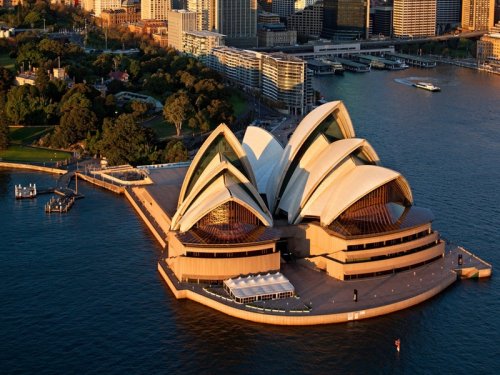
Sydney
Opera House
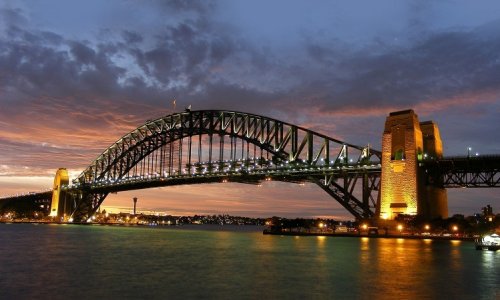
Harbor
Bridge
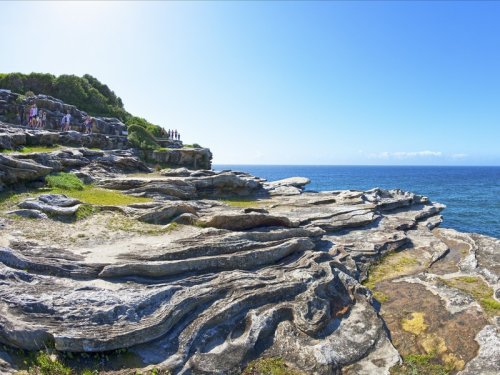
Bondi to Coogee coastal trail
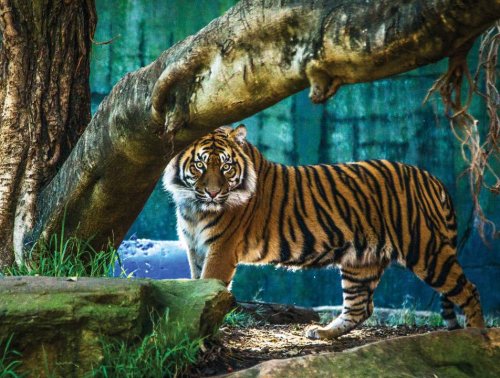
Taronga Zoo
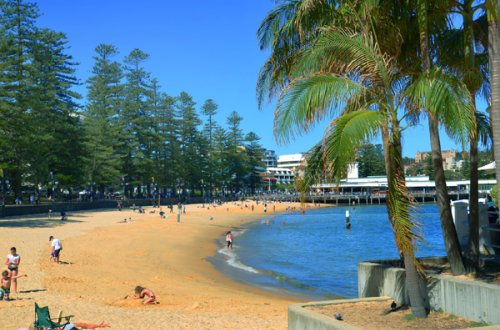
Manly
Beach
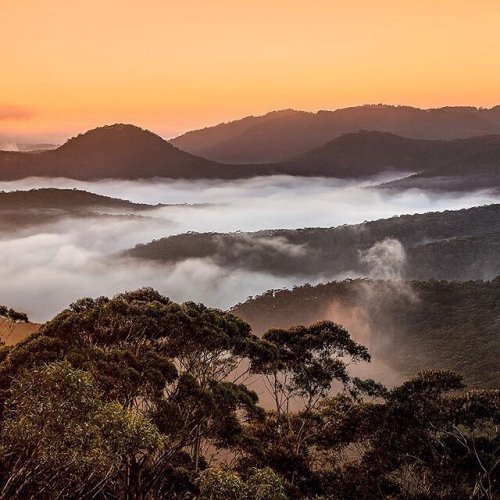
Blue Mountains
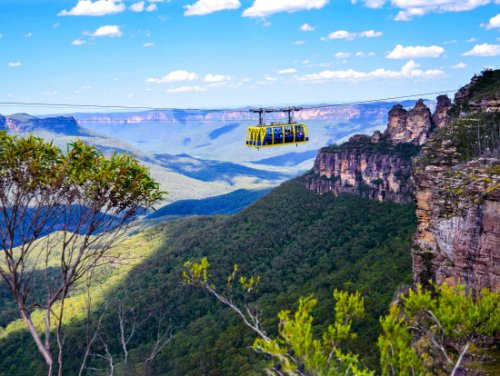
Gondola
Ride to Scenic World and Blue Mountains.
See the Three Sisters rock formation on the right.
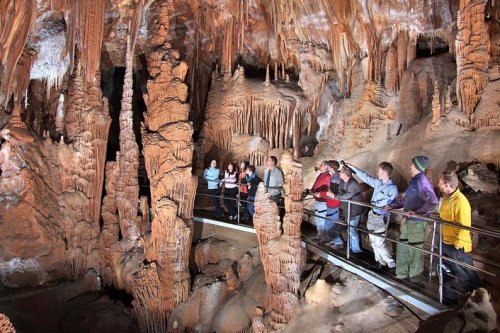
Jenolan
Caves

Botanic
Garden |
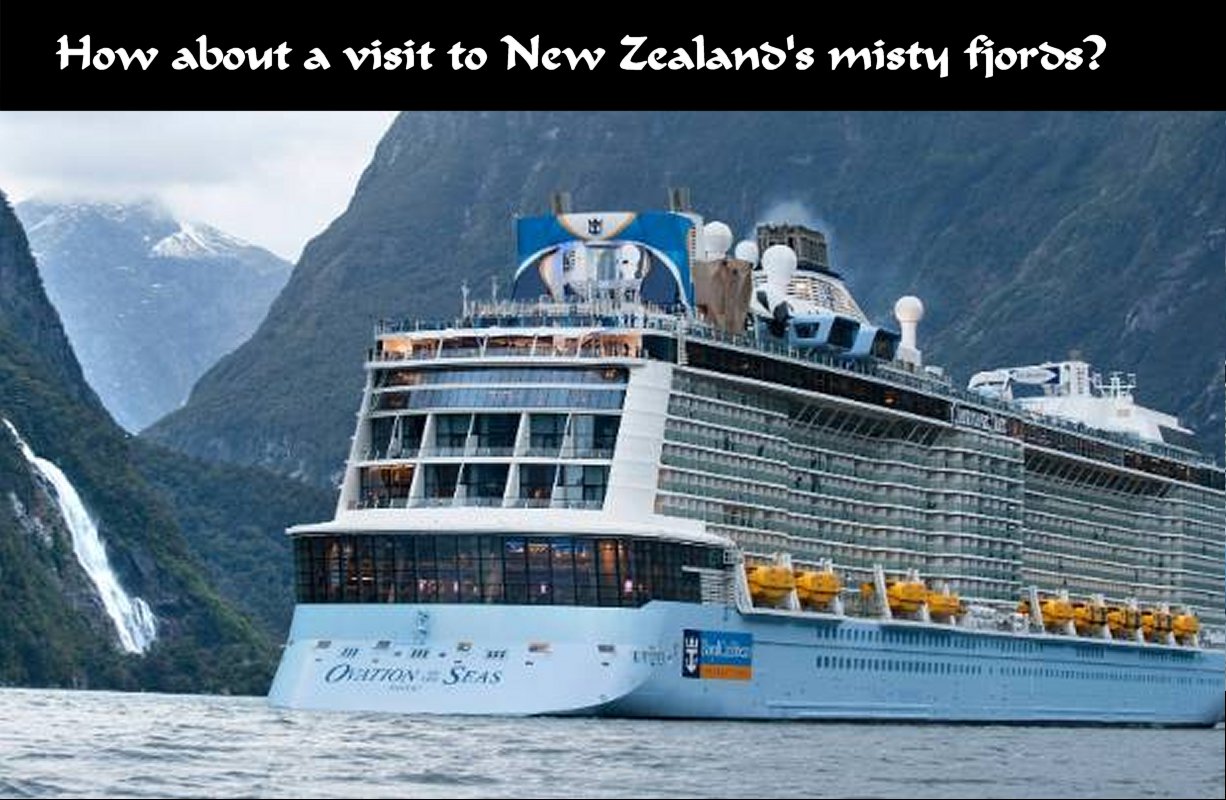 |
| |
|
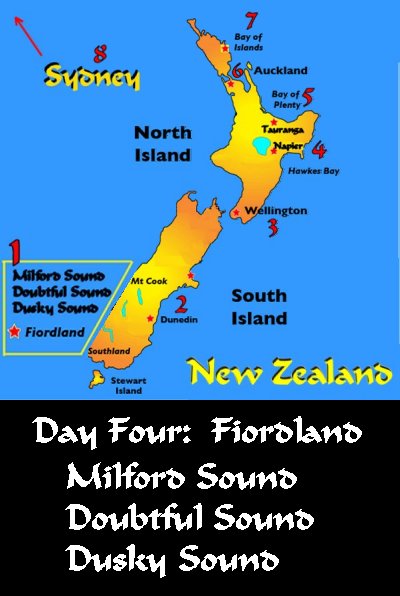 |
Fiordland is a
geographic region of New Zealand in the southwestern corner
of the South Island. It comprises the western-most
third of Southland.
Most of
Fiordland is dominated by the steep sides of the snow-capped
Southern Alps, deep lakes, and its steep, glacier-carved and
now ocean-flooded western valleys.
Due to the often
steep terrain and high amount of rainfall supporting dense
vegetation, the interior of the Fiordland region is largely
inaccessible. As a result, Fiordland was never subjected to
notable logging operations, and even attempts at whaling,
seal hunting, and mining were on a small scale and
short-lived.
Our cruise trip
will not actually dock in Fiordland, but rather sail through
and treat us to the spectacular views. You may have an
opportunity to spot some of the area's wildlife in the
water, such as dolphins and seals.
As it turns out,
there are twelve different fiords. Our ship will take
us to the three most important: Milford Sound,
Doubtful Sound (love that name!), and
Dusky Sound.
.
|
Milford Sound
Situated on the
west coast of the South Island, Milford Sound is a fusion of
spectacular natural features with amazing visual cues around
every corner.
Described by Rudyard Kipling as the 'eighth wonder of the
world', Milford Sound was carved by glaciers during the ice
ages. Breathtaking in any weather, the fijord's cliffs rise
vertically from the dark waters, mountain peaks scrape the
sky and waterfalls cascade downwards from as high as 1000
metres. When it rains in Milford Sound, and it often does,
those waterfalls multiply with magnificent effect.
The first thing that strikes many visitors is the diverse
nature of the scenery. Staggering mountains rest
side-by-side with lush waterfalls. Those who see Milford
Sound wildlife are also struck by how diverse it is, as well
as how all its inhabitants live together in harmony.
Milford sound has a long and interesting history, from early
Maori habitation to the first European explorers. Milford
Sound was recognized by early colonists as a very special
place and it been visited by curious explorers for over 200
years. Nineteenth century botanists have found rare plant
life and the earliest photographers have documented it's
natural wonders.
Milford Sound rich and varied history has been a resource
for Maori for around 1000 years. The famous English naval
commander, Captain Cook passed the entrance to Milford Sound
twice and so the European "discovery" of Milford Sound is
credited to Welsh adventurer John Grono. Despite modern
access by road, sea and air, Milford Sound retains it's
natural beauty and still attracts an abundance of wildlife
including dolphins, fur seals, penguins and many different
sea birds.
Doubtful Sound
The grandeur of
towering peaks descending into deep waters, outstanding
waterfalls and fjords covered with ancient vegetation, all
make up the unforgettable solitude and serenity of Doubtful
Sound, New Zealand.
Practically untouched by man, the physical grandeur of
towering peaks descending into moody waters, outstanding
waterfalls from high-up ice-age valleys and fiords clad with
ancient vegetation, create a powerful atmosphere of solitude
and serenity. Its rugged peaks, verdant rainforest and
twisting, hidden inlets will take your breath away.
Doubtful Sound is the second largest fiord in Fiordland
National Park. Three times longer than Milford Sound and
with a surface area 10 times larger, this is an unspoiled
wilderness of many moods.
Located deep in the heart of Fiordland, and almost
inaccessible to humans, Doubtful Sound is within a temperate
rainforest and home to a largely undisturbed wildlife.
First named 'Doubtful Harbour' by Captain Cook, who was
unsure of whether or not the inlet was navigable, was later
renamed Doubtful Sound by whalers and sealers. The sound is
home to several large waterfalls, notably Helena Falls at
Deep Cove, and the Browne Falls, which have a fall of over
600 meters. The fjord also protects the southernmost
population of bottlenose dolphins as well as fur seals,
penguins, and numerous sea creatures such as sea anemones,
coral and starfish.
Dusky Sound
Dusky Sound in southern Fiordland is one of the most remote
parts of the New Zealand mainland. Dusky Sound, New
Zealand's longest fjord, is also one of the most beautiful,
with numerous wooded islands and inlets.
It was given its name by Captain Cook, who sailed past the
fjord on his first voyage, in 1770, as evening was falling.
First impressions are that nothing has changed since Captain
Cook entered Tamatea/Dusky Bay.
It looked too forbidding to enter and Captain Cook named it
Dusky Bay before sailing on by. It was three years later on
his second voyage to these parts that he penetrated its
dark, forest-laden shores. In a sense, it is ironic that
Dusky Sound has remained as untouched as it has because it
hosted New Zealand's European settlement, a short-lived base
for sealers and whalers in the late 18th century.
The upper reaches of the sound are steep-sided, and the high
precipitation of the region leads to hundreds of waterfalls
cascading into the sound during the rainy season.
|
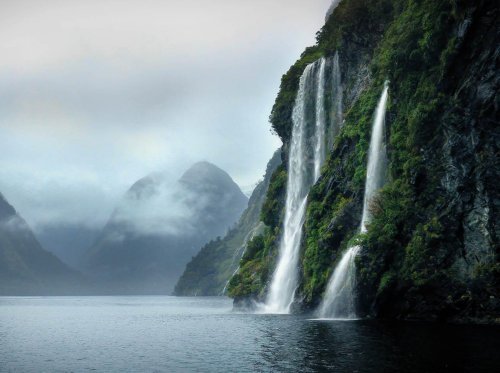
Milford
Sound
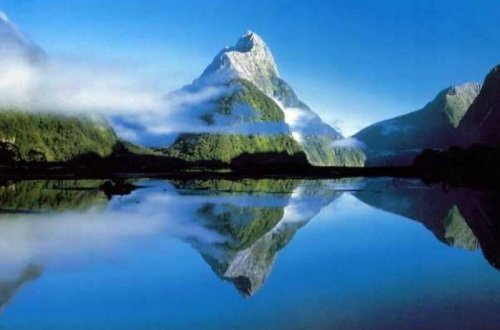
Doubtful
Sound
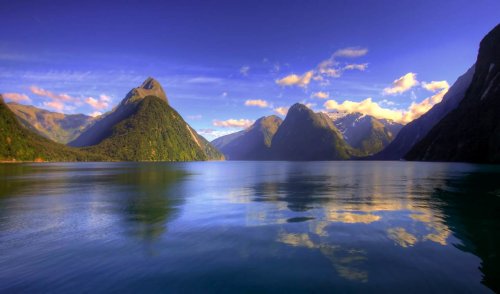
Doubtful
Sound
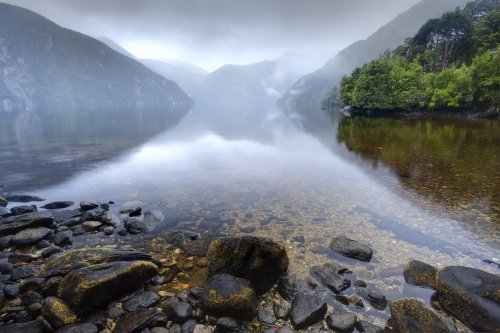
Dusky
Sound |
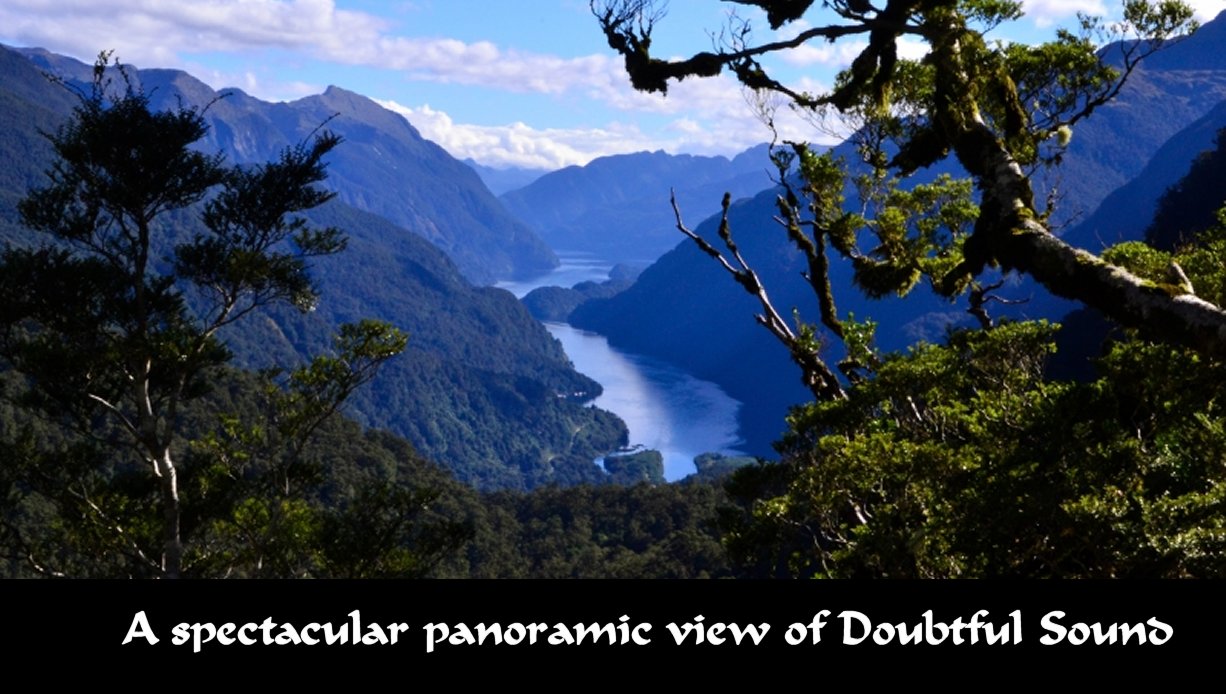 |
| |
|
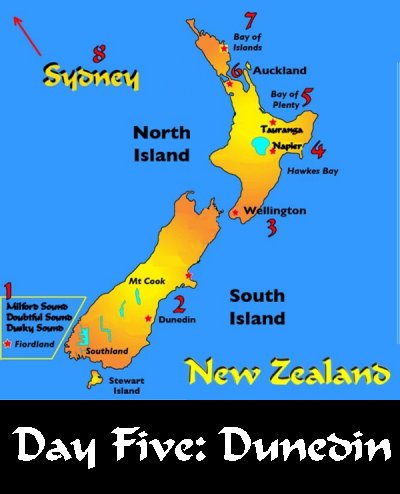 |
Dunedin (duh-NEE-din)
is the second-largest city in the South Island of New
Zealand.
Its name comes from Důn Čideann,
the Scottish Gaelic name for Edinburgh, the capital of
Scotland. Known as the
Edinburgh of New Zealand, Dunedin is the country's city of
the south, wearing its Scottish heritage with pride.
Surrounded by dramatic hills and at the foot of a long,
picturesque harbor, Dunedin is one of the best-preserved
Victorian and Edwardian cities in the Southern Hemisphere.
Nightlife buzzes with funky bars and delicious restaurants
and the natural attractions are unique and fascinating.
Archaeological evidence points to
the area having been long inhabited by Maori prior to the
European arrival. In 1848 a Scottish settlement was
established by the Lay Association of the Free Church of
Scotland. Between 1855 and 1900 many thousands of Scots
emigrated to the incorporated city. Dunedin became wealthy
during the Central Otago Gold Rush, beginning in the 1860s.
While Tauranga, Napier and
Hamilton have eclipsed the city in size of population since
the 1980s to make it only the seventh-largest urban area in
New Zealand, Dunedin is still considered one of the four
main cities of New Zealand for historic, cultural and
geographic reasons.
The harbor and hills around Dunedin
are the remnants of an extinct
volcano. Dunedin is a region
of unique landscapes and fascinating cultural history. Enjoy
getting close to rare wildlife and soaking up
the traditions of this unique city.
Don't miss a drive up the Otago Peninsula - the views are
endless and the beaches are beautifully rugged. Nestled at
the foot of Taiaroa Head is the Royal Albatross Centre, the
only place in the world on the mainland where you can view
Northern Royal Albatross in their natural habitat. On
Dunedin's doorstep you will also find incredible wildlife
including the world's rarest penguin colonies.
|
Points of
Interest
Dunedin Railway Station
In the early 1900s Dunedin was the commercial center of New
Zealand. In 1906 this magnificent railway station was
opened.
Today the station remains, fully restored to its former
glory. The ornate Flemish Renaissance-style architecture
features white Oamaru limestone facings on black basalt
rock. The sheer size, grandiose style and rich
embellishments of the station earned architect George Troup
the nickname of Gingerbread George.
The booking hall features a mosaic floor of almost 750,000
tiles of Royal Doulton porcelain. The one kilometre main
platform is the country's longest and every year in October
becomes what is probably the world's longest catwalk, for
the South Island's main fashion show.
An excellent tourist excursion service is the only train now
using the station. Much of its ground floor is used as a
restaurant, and the upper floor houses an art gallery and a
sports hall of fame.
Visitors are welcome to view the exterior from the well kept
grounds and wander inside to marvel at the ornate interiors.
Taieri Gorge Train
A highlight of your visit to Dunedin is a trip on the Taieri
Gorge Railway - one of the world's great train trips and one
of Dunedin's top attractions. Departing daily from downtown
Dunedin into the Taieri Gorge, this trip travels through
some of New Zealand's most beautiful and ever changing
scenery which can not seen from the road! With sightseeing
stops, on board cafe, outside viewing platforms it is the
perfect all weather activity and one of the key attractions
in Dunedin.
Take a scenic round-trip through
the wilds of New Zealand's South Island on a Taieri Gorge
railway journey from Dunedin. Depart from downtown Dunedin's
attractive railway station and head deep into the Taieri
Gorge by train. Gaze out over ever-changing corners of the
New Zealand countryside inaccessible by road. With
informative and entertaining live commentary on board, gain
insight into the railway's construction and the challenges
faced by the engineers. Enjoy sightseeing stops on route and
discover top attractions around Dunedin.
The stunning Taieri Gorge Railway is a world class train
trip and one that should not be missed.
Larnach Castle and Gardens
Discover New Zealand's only Castle,
built 1871 by William Larnach, merchant baron and
politician, for his beloved first wife Eliza. It took more
than 200 workmen three years to build the Castle shell and
master European craftsmen spent a further 12 years
embellishing the interior. Larnach spared no expense on his
dream home, which features the finest materials from around
the world.
The Castle is still privately owned and cared for by the
Barker family who purchased it as their home in 1967.
Decades have been spent on the Castle's restoration, with
the family having restored empty buildings from ruin and
assembled a large collection of original New Zealand period
furniture and antiques. This living collection showcases the
craftsmanship and spirt of New Zealand.
Open to the public throughout, this conservation project has
been funded through admission fees. The family has always
been committed to opening their home and sharing this
significant period of Dunedin and New Zealand's history.
Scandalous and tragic stories, spectacular tower views and a
Garden of International Significance complete this enjoyable
award-winning experience
The gardens at Larnach Castle have been rated by the New
Zealand Gardens Trust as a Garden of International
Significance. Today, the Castle is surrounded by 7 acres of
maintained Gardens.
There is always something to see in the gardens at Larnach
Castle. This is more than just a Garden of International
Significance; it is a unique collection of specialized
gardens. There is a Patterned Garden, the Lost Rock Garden,
the Serpentine Walk, the Rain Forest, the South Seas Garden,
the Alice Lawn, and the Laburnum Arch and Green Room.
To assist in exploring the gardens, a color map is provided,
with features to be found including the Wishing Well, the
Dungeon, a Methane Gas Generation Plant and a challenge to
find the Oamaru Stone Cheshire Cat!
Purakaunui Park
can be reached by car. It is located 25 minutes
from Dunedin. Attractions
include walking, bird-watching, kayaking, swimming,
surfing, fishing and yachting. Be
sure to see the spectacular water falls.
|
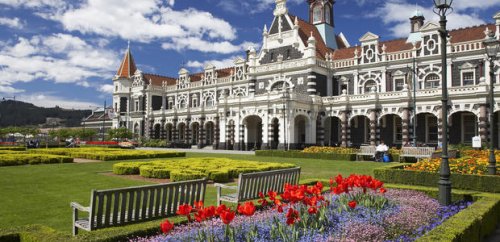
Dunedin
Railway Station
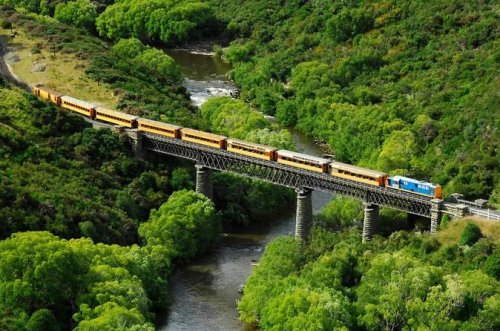
Taieri
Gorge Train
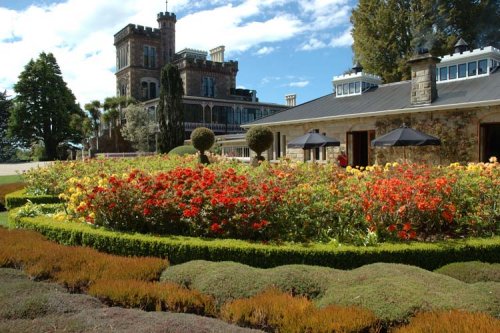
Larnach
Castle and Gardens
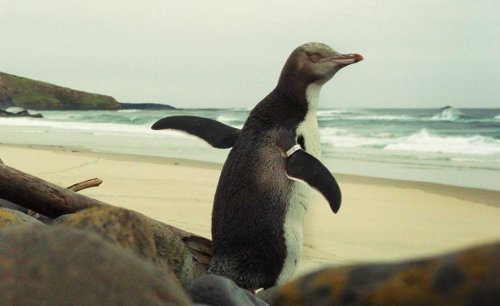
New
Zealand is 1,500 miles from Antarctica
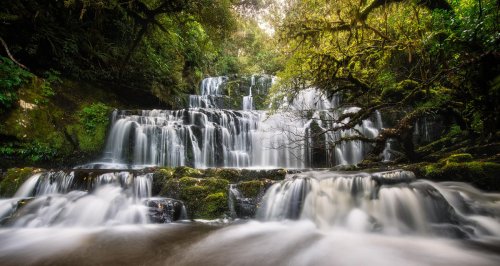
Purakaunui
waterfall
|
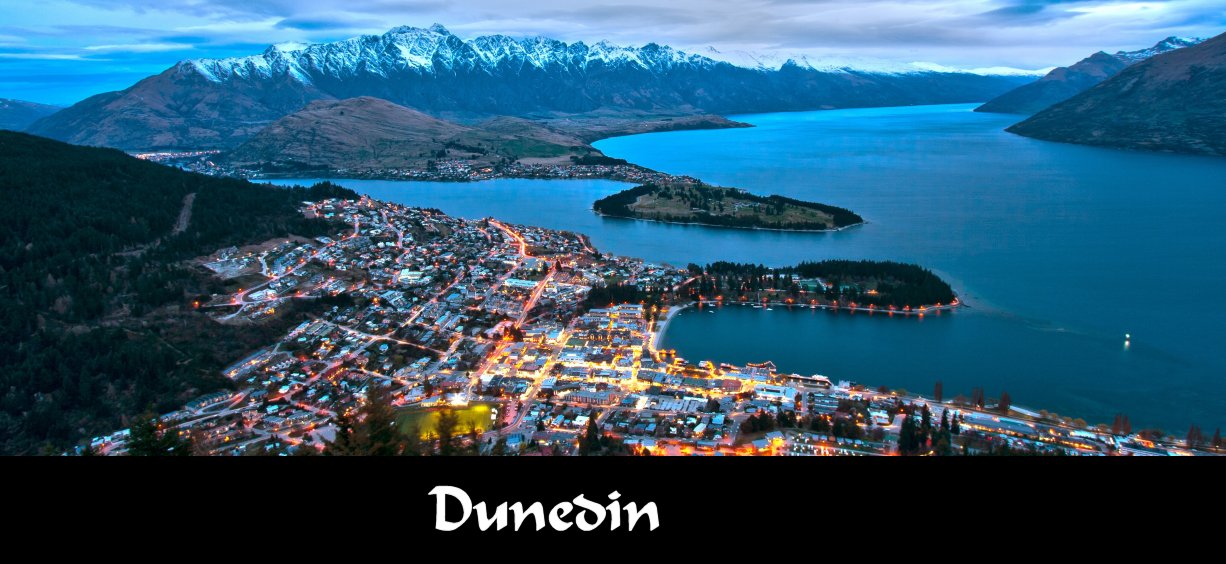 |
| |
|
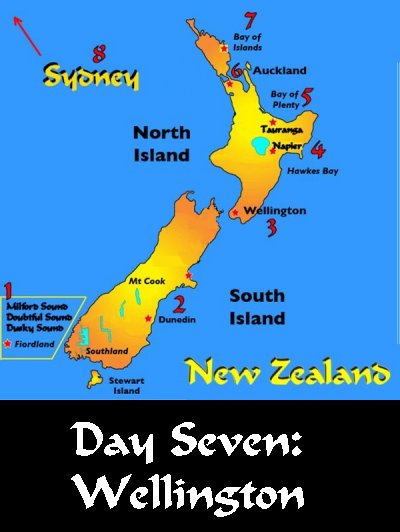 |
Wellington is the
capital city and second most populous urban area of New
Zealand, with 412,500 residents. It is located at the
south-western tip of the North Island, between Cook Strait
and the Rimutaka Range. Wellington is known as the world's
windiest city, with an average wind speed of over 26 km.
For you trivia buffs, it is also the world's southernmost
capital of a sovereign state.
The earliest date with hard evidence for Maori living in New
Zealand is about 1280.
European settlement began with the arrival of an advance
party of the New Zealand Company on the ship Tory on 20
September 1839, followed by 150 settlers on the Aurora on 22
January 1840.
Situated at the
southern end of the North Island, Wellington, New Zealand,
was recently named "the coolest little capital in the world"
by Lonely Planet.
Many points in Wellington are accessible by walk on walk off
from the ship.
A pedestrian
city, the easiest way to discover the essence of Wellington
is on foot. Malls and side alleys connect its streets, cafes
spill from refurbished Victorian buildings, the waterfront
inspires new and exciting public spaces, and eclectic street
art is scattered throughout.
Downtown
Wellington is an ideal shopping destination. Considering how
compact the city is, it takes no more than twenty minutes to
walk from one end of downtown to the other. The city's
best-known shopping area is Lambton Quay on Willis Street,
also called the Golden Mile for its row of department and
designer stores. For a more bohemian alternative, visit Cuba
Street. Here you'll find markets, alternative boutiques,
secondhand stores and, of course, great cafés.
|
You'll find
plenty to see and do within Wellington's compact downtown
area. Make time to explore the wildlife areas surrounding
the city too.
Walk or take a bus from the city to the summit of Mount
Victoria for a 360-degree panorama of Wellington. Enjoy
fantastic city and harbor views.
Walk around the stunning waterfront and follow the
Wellington Writer's Walk - quotes from New Zealand writers
are celebrated in large stone sculptures.
While you are at the waterfront, why not stop at Te Papa. It
is an innovative national museum and a world leader in
interactive experiences. New Zealand's history, art and
people are showcased in fun and interesting exhibitions.
Te Papa is the
most visited museum in Australasia and entry is free for
most exhibitions.
Cable Car
Jump on the famous Wellington cable car and climb the hill
from downtown Lambton Quay to the Botanic Garden. There are
sweeping views of the city and harbor.
Wellington offers plenty of outdoor opportunities. For
starters, there's the terrific 8K Red Rocks Coastal Walk
along the southern coastline, past the lava formation of Red
Rocks to the seal-covered shores of Sinclair Head. If you're
up for a tougher test, you could go on a rock-climbing
excursion or hire sea kayaks. You also have the option of
hiring a 4-wheel-drive ride for a trip to the rugged hill
country with spectacular views of Cook Strait and the South
Island.
Zealandia
For you nature lovers, visit Zealandia, the world's first
fully-fenced urban ecosanctuary, with an extraordinary
500-year vision to restore a Wellington valley's forest and
freshwater ecosystems as closely as possible to their
pre-human state.
The 500 + acre ecosanctuary is a groundbreaking conservation
project that has reintroduced 18 species of native wildlife
back into the area, some of which were previously absent
from mainland New Zealand for over 100 years.
Set around a picturesque reservoir, ZEALANDIA is home to
some of New Zealand's most rare and extraordinary wildlife -
all thriving wild in a world-first protected sanctuary.
|
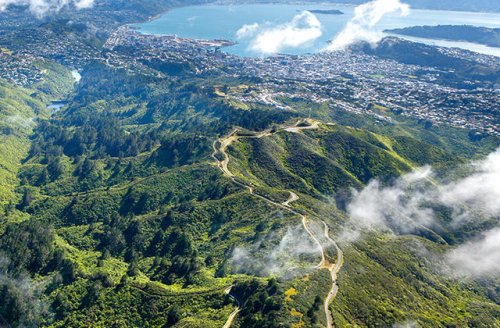
Zealandia
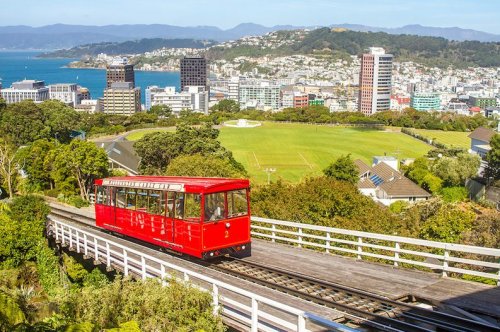
Cable Car
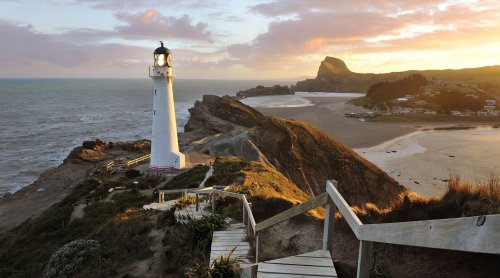 |
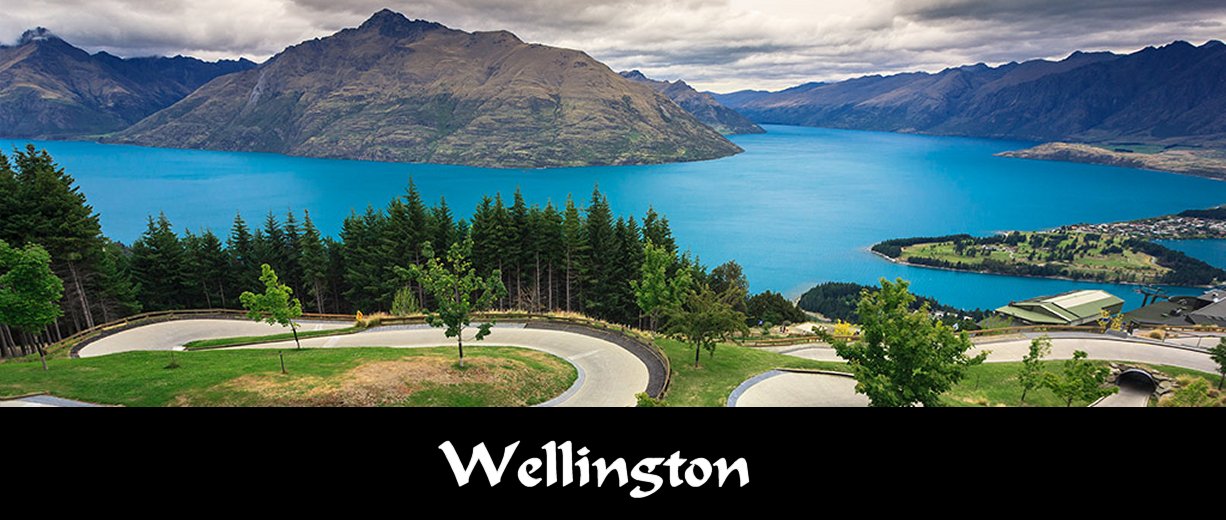 |
| |
|
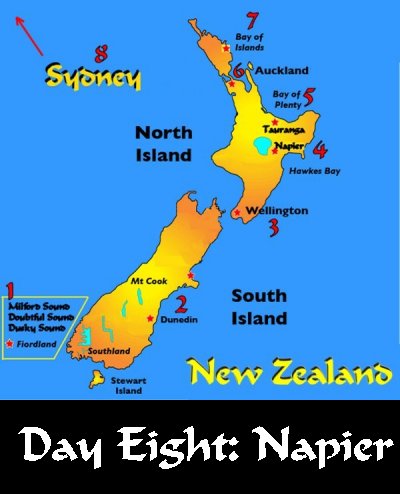 |
Napier is a seaport
located in Hawke's Bay on the eastern coast of the North
Island. The population of Napier is about 63,100
Napier is one of
New Zealand's most attractive cities with beautifully
preserved 1930s architecture which provides Napier a special
point of difference. Rivalled only by Miami beachfront's
Streamline Moderne, it is the most comprehensive Art Deco
styled town in the world.
Palm trees line the inner-city streets and the wonderfully
sculpted Marine Parade, as the name suggests, runs along the
shore of the city. Along Marine Parade various parks,
gardens and memorials give the water's edge its distinct
character.
A national disaster resulted in Napier becoming one of the
purest Art Deco cities in the world. In 1931 a massive
earthquake rocked Hawke's Bay for more than three minutes,
killing nearly 260 and destroying the commerical centre of
Napier.
Rebuilding began
almost immediately, and new buildings reflected the
architectural styles of the times - Stripped Classical,
Spanish Mission and Art Deco.
|
Napier's city
center has the feeling of a time capsule - the seamless line
of 1930s architecture is quite extraordinary. One of the
ways to enjoy the streetscape is on a self-guided walk - ask
for a map at the information center at the Art Deco Trust.
The port is also
a gateway to exploring the Maori heritage, seascapes and
wildlife of Hawke's Bay and the many vineyards and wineries
in the region.
The National Aquarium of New Zealand on Marine Parade is a
Napier destination you wouldn't want to miss. Opened in
March 2002, it has a huge ocean tank with an observation
tunnel and holds the most comprehensive collection of marine
life in the country. The aquarium's magnificent architecture
resembles a stingray. Exhibits include kiwis, piranhas,
crocodiles and every sea creature you could imagine.
Napier is the
home of New Zealand wine, housing the oldest wineries and
wine-making establishments in the country. With some of the
best sunshine hours in New Zealand, mountainous shelter from
prevailing westerly winds, and refreshing sea breezes, not
only is Napier a great climate for visiting, but is ideal
for grape growing.
Hawkes Bay is
New Zealand's oldest winemaking region, home to New
Zealand's oldest winemaking establishments, some producing
wines for over 140 years. Today the Hawkes Bay is New
Zealand's second-largest wine region, leading the country
with 70% of Cabernet Sauvignon and 30% of Chardonnay
production. It also produces high quality Syrah, Sauvignon
Blanc, Riesling and sweet dessert wines, while smaller
boutique wineries are constantly experimenting with new
varieties.
Why not book yourself on a tour or grab a wine map and take
yourself? From boutique wineries to major operations, you're
bound to find something special to swirl around your glass.
Shine Falls is
one of New Zealands' most spectacular sights.
Unfortunately it is a 90 minute drive... 3 hours both
ways... and we are only in Napier for 6 hours. So it
is do-able... but don't linger.
.
|
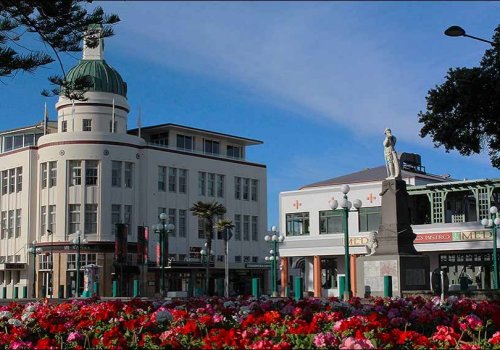
Art Deco
Trust
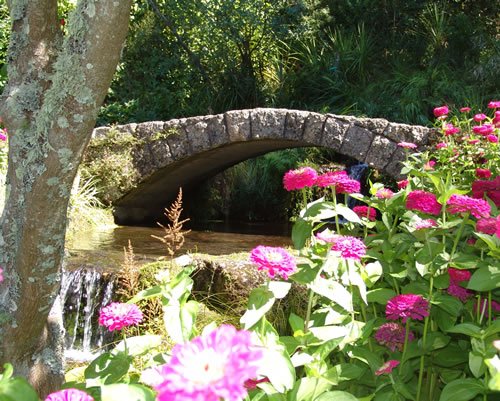
Botanical
Garden |
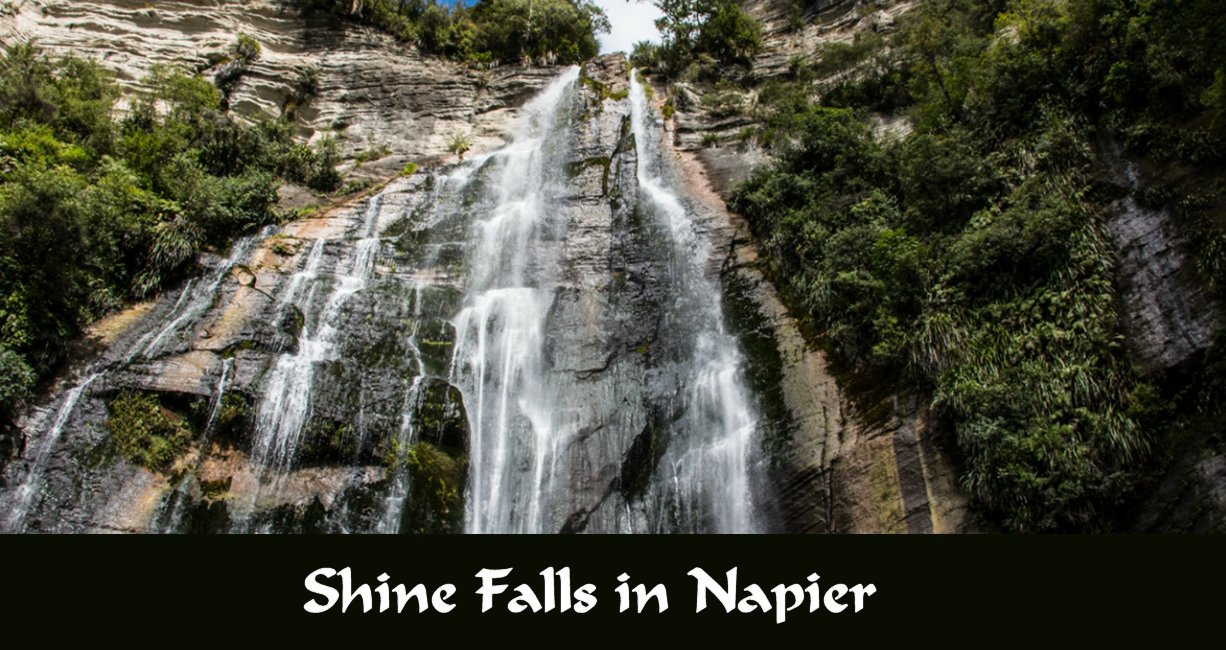 |
| |
|
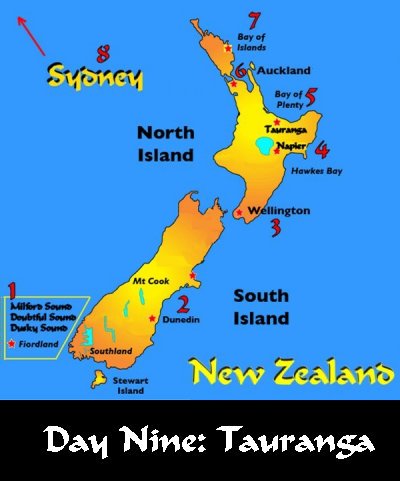 |
Tauranga is a
beautiful coastal city looking out over the wide Bay of
Plenty to the north with Mount Maunganui arising
conspicuously to the north east and the forested hill
country of the central North Island to the south.
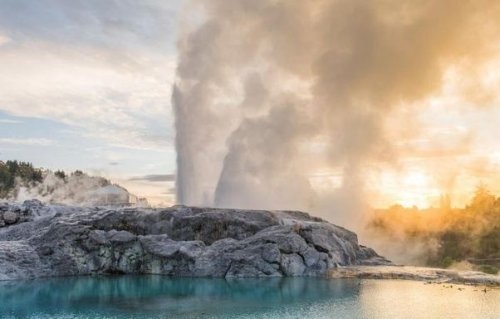
Pohutu
Geyser
|
Tauranga was first discovered and named in the 13th Century
by the Maori. "Tauranga" meaning is 'the place of rest or
anchorage'. It has grown rapidly in recent years and now
offers cosmopolitan city living combined with a laid-back
atmosphere.
No visit to
Tauranga would be complete without a trip to Mount Maunganui.
Reminiscent of
Diamondhead, the extinct volcano that looms over Waikiki
Beach in Oahu, Hawaii, Maunganui is a perfect example of New
Zealand's extremely mountainous landscape. This
extinct volcanic peak rises from the mists of Tauranga
Harbour, attracting tourists from all over New Zealand and
abroad. Known as simply "the Mount" to locals, Mount
Maunganui is home to a spectacular beach nestled at the
southern end of Tauranga harbor.
The sheltered
inner bay offers warm waters and white sandy beaches, while
the ocean side is a surfers' paradise. The area, once a
Maori stronghold, now houses the resort town of Maunganui,
which is known for its tiled pavements lined with palm
trees, turquoise-painted street lamps and gorgeous
coastline. And while you're here, take a dip in the hot
saltwater pools located at the base of the mountain.
Head just
outside of town to the site of Te Puia, which includes a
thermal valley, the Pohutu geyser, mud pool, and the
Pikirangi Maori village. Soak your tired limbs in the
rejuvenating thermal pools and then learn more about Maori
culture at the carving and weaving schools.
If you're timing
is right, you just might get to witness the spectacular
sight of the Pohutu geyser shooting nearly 100 feet into the
sky. Explore walking tracks and waterfalls, or take your
courage with you to the TECT All Terrain Park to experience
high wire adventures, mountain biking and motorsport
activities.
Visit Kaimai Mamaku Forest Park located in the Kaimai
mountain range, the natural park is part of a natural
barrier between the Bay of Plenty and Waikato regions. With
over 200 miles of hiking and walking trails, nature lovers
will find plenty of local flora and fauna to observe.
Or if you are
feeling lazy, relax on one of the many golden beaches that
make this area popular with surfers, sailors, and divers.
Venture out on the water for dolphin watching, or even a jet
boat ride if you have a need for speed. Grab a bite to eat
and a refreshing glass of New Zealand vino on the Strand-a
waterfront area is filled with restaurants, cafés, and pubs,
which is also the perfect location for people watching.
|
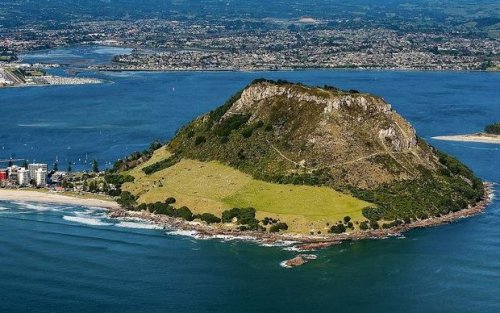
Mount
Maunganui
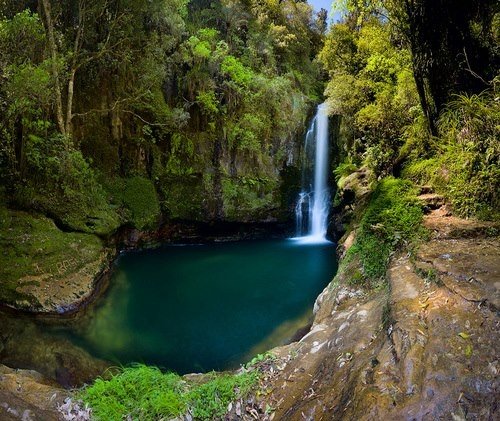
Kaimai
Mamku Forest Park |
Auckland is located
on an isthmus in the northern part of the North Island.
For those of you
who have no idea what an 'isthmus' is, it is a narrow strip
of land with sea on either side, forming a link between two
larger areas of land.
Auckland has two
harbors and two bays.
In this case,
Auckland can be accessed from the West Coast or the East
Coast with ease.
One imagines
this unusual geography makes Auckland the answer to the
Trivia Question... which is the largest city in the world
built on an isthmus.
By the way,
there is a major USA city built on an isthmus. Can you
name it??
Answer below in
the Trivia section.
|
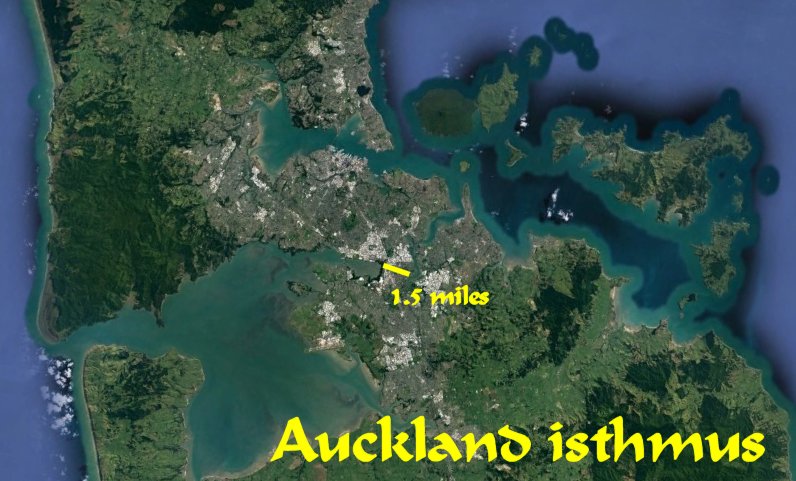 |
| |
|
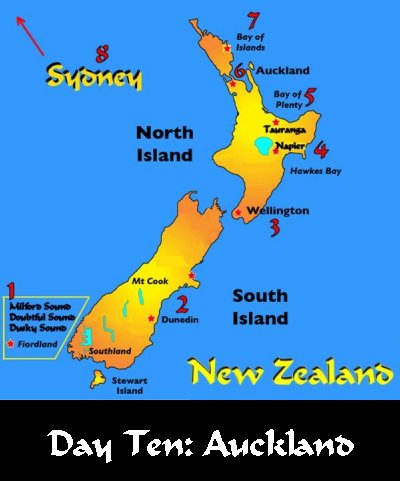 |
Auckland
is the largest urban area in the country, with an urban
population of around 1,600,000. Auckland is a
buzzing urban hub nestled between two contrasting
coastlines. The city hosts a combination of
metropolitan delights and natural landscapes. The
harbor side city of Auckland is surrounded by natural
attractions. There are so many beautiful places to see.

|
Auckland's diverse
landscapes provide countless opportunities to get immersed
in nature. To the west, a lush native rainforest plunges
down the hills to meet the sea on dramatic black sand
beaches, while the east sheltered golden sand beaches are
fringed with red-flowering pohutukawa trees. To the north
the rolling hills of wine country meet stunning coastlines
and in the south you'll find picturesque country gardens,
unspoiled forest and tranquil bays to explore.
The Waitakere
Ranges, spanning West Auckland, are around 30 minutes from
the city and are home to lush native bush, stunning
waterfalls and walking tracks.
With over 150 miles of walking tracks, the ranges are a
wonderful place to explore on foot, surrounded by
spectacular scenery. Favorite scenic spots like the Karekare
Falls, just a few minutes' walk from Karekare beach, are
very accessible.
Popular short walks deeper into the ranges include Kitekite
track, only a 45 minutes walk, where you'll discover
waterfalls, streams, pools and beautiful native bush.
Native plant life includes nikau palms, silver tree ferns
and regenerated kauri. Listen out for the call of the
tui and look out for adventure seekers canyoning down the
giant six-tier waterfalls.
Just past these ranges you'll find the ruggedly beautiful
black-sand beaches of Piha, Muriwai, Bethells and Karekare.
Auckland's East
Coast is home to more tranquil coastline that looks out to
harbors dotted with islands. Don't miss a visit to Goat
Island - a marine reserve and snorkeling mecca; Tawharanui
Regional Park, or the quaint beaches of Devonport.
Auckland is also home to 48 dormant and extinct volcanic
cones, many of which offer spectacular walking paths and
views at the top. Don't miss a short hike up Mount
Eden, where you'll find panoramic views of the Auckland
region, or catch the ferry to Rangitoto, a volcanic island
in the Auckland Harbour.
Auckland Hauraki Gulf Marine Park encompasses an incredible
3 million acres of coast, sea and islands and there are so
many ways to explore it.
The jewel of the Hauraki Gulf is Waiheke Island, a haven of
beautiful vineyards, olive groves, farm land and golden
beaches - and only a 35-minute ferry ride away from downtown
Auckland. Sip on award-winning wines at some of the 30
boutique vineyards and wineries, enjoy fine dining and pick
up superb local artwork.
Make sure you get out on the water while you're here,
whether it's a relaxing harbor cruise, a fishing charter,
whale and dolphin spotting, diving, kayaking or surfing.
Enjoy a visit to Auckland's Botanic Gardens. With more than
10,000 beautiful and fascinating plants, Auckland Botanic
Gardens is a gardener's nirvana.
Enter through the award-winning visitor center and begin
your visit with the refreshingly different edible garden.
Here fruit, vegetables, nuts and edible flowers are featured
to encourage people who want to grow more of their own food.
You will have a wonderful opportunity to find out more about
the unique features of New Zealand's natural vegetation. A
special feature of this garden is the collection of
threatened native species.
Deeper into the gardens, past the lower lake, things become
a little more exotic. Palms from around the world grow
alongside many mature native trees in a delightful setting
with two meandering streams. Color becomes the focus
throughout the extensive rose, camellia and magnolia
gardens. From here the spring blossom valley leads to the
African garden, a collection of plants from the southern end
of Africa - an area regarded as one of the world's richest
floral kingdoms.
Passing the
upper lake and the intriguing rock garden, the edible theme
emerges once more at the aromatic and informative herb
garden. Signage also explores the contribution that herbs
make to medicines, dyes, insect repellents, cosmetics and
perfumes.
New Zealand's indigenous Maori people called this land Tmaki
Makaurau, a maiden desired by a hundred lovers. It was a
place fought over for its vast riches, including its
forested hills, productive volcanic soils and harbors full
of seafood. The name still holds true, as Auckland's
lifestyle is ranked among the best in the world.
One more thing -
the golf courses in Auckland are spectacular.
|
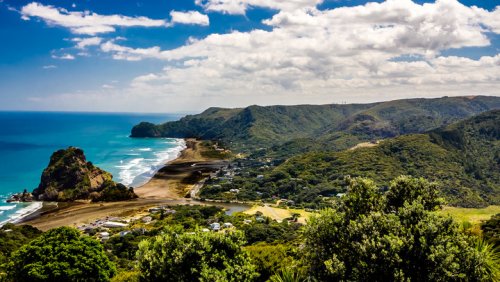
Waitakere
Range
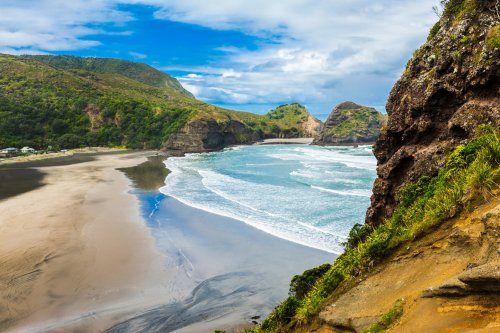
Piha Beach
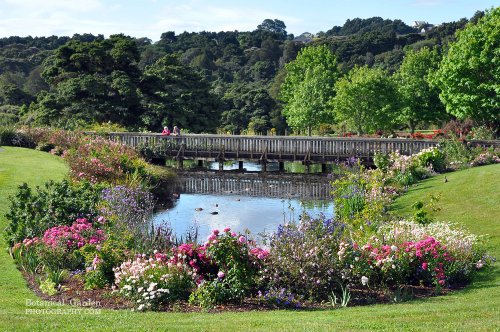
Botanic
Gardens
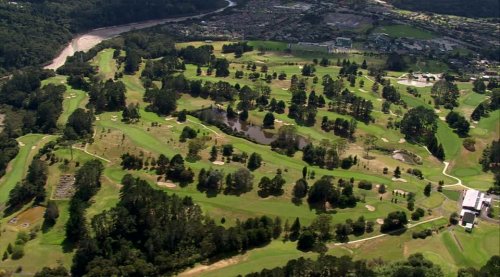
Golf
Course |
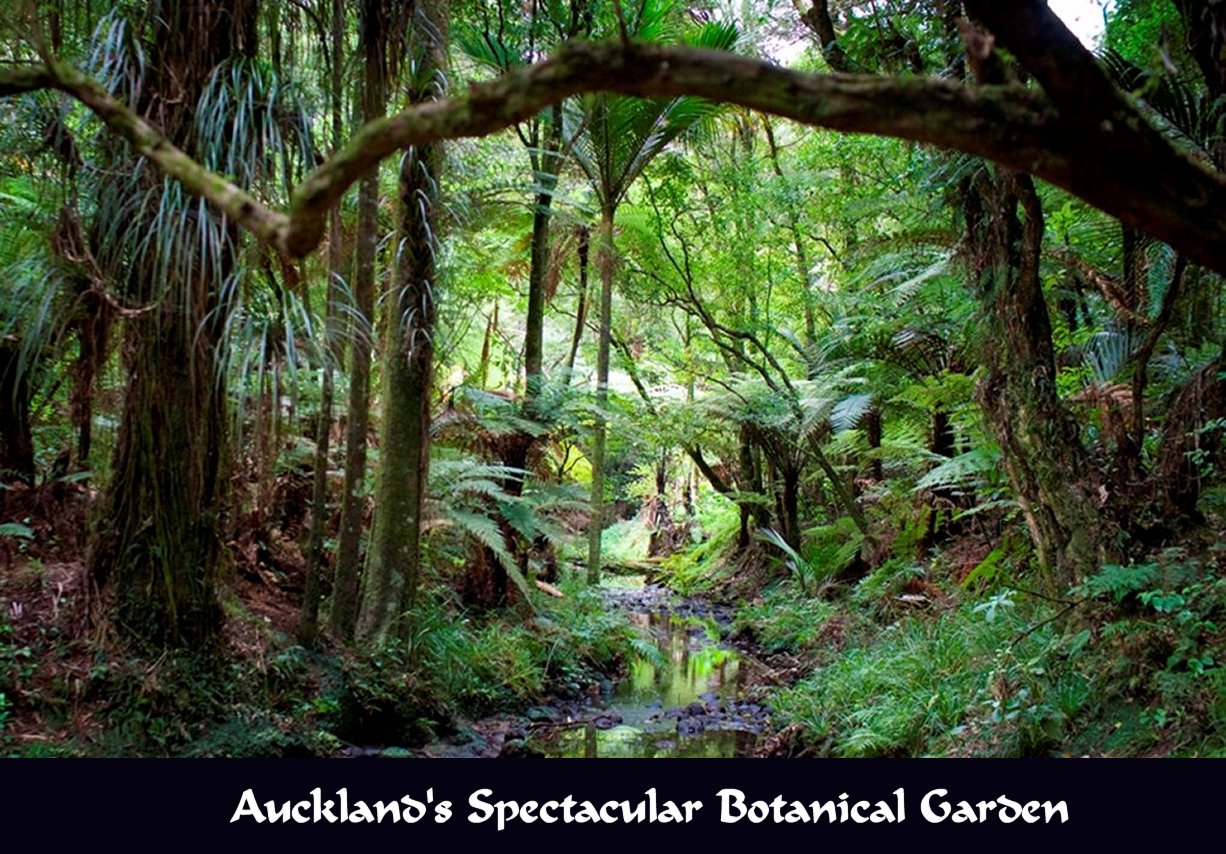 |
|
BAY OF ISLANDS, NEW ZEALAND
|
| |
|
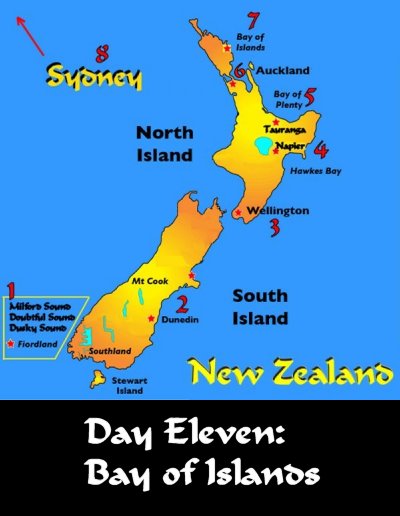 |
The Bay of Islands
is an area on the east coast of the Far North District of
the North Island of New Zealand. It is one of the most
popular fishing, sailing and tourist destinations in the
country as well as s one of the most picturesque sites in
all of New Zealand. The Bay of Islands is a stunningly
beautiful length of sand and rock coastline that circles a
sea pierced by 150 islands, secluded bays and an abundance
of marine life.

Since there is
so much to see, perhaps the best way to appreciate the
beauty is to take a day trip on an excursion boat.
|
These islands comprise the archipelago of small islands in
the Bay of Islands. Most of them are uninhabited by man,
many are still unexplored. About the only island which has
some facilities is Urupukapuka Island lying northeast of
Russell. There are some 40 sites on the islands which are
part of the Bay of Islands Maritime and Historic Park. Its
visitor information centre is at Russell. These islands may
have marked walks, Maori pas and other historical sites, as
well as recreation reserves.
There are many
activities to select from: sailing, fishing, snorkeling,
swimming to golfing walking, eating out - it's all there.
Swimming with dolphins is a favorite thing to do in the Bay
of Islands. Many operators in the region offer excellent
trips to spectacular Cape Brett and the 'Hole in the Rock'
on Piercy Island.
Wherever you are in the Bay of Islands, it's impossible to
escape the lure of the sea. Catch a ferry or charter
boat and immerse yourself in the blue-green world of island
and beach. Or paddle a sea kayak in and out of island nooks
and crannies.
The townships of this historical bay are alive with memories
of the area's colorful history. Visitors are welcome to
explore the well-preserved relics of the past, both Maori
and European, in romantic Russell, Paihia, Waitangi or
Kerikeri.
The Bay of Islands was the site at which the earliest
contact between the indigenous population and European
settlers took place. Visit Waitangi to see the treaty house,
where New Zealand's founding document was signed by Maori
and Pakeha leaders.
Russell, once the rowdy and bustling capital of New Zealand,
today maintains a lively and casual island feel due to its
isolation from the mainland. From here walk north to
Flagstaff Hill, a reserve that was once the scene of a
historic confrontation between Maori leader Hone Heke and
the British Colonials. The flag pole flying the Union Jack
was severed four times before war settled the dispute.
Kerikeri, the earliest permanent settlement in New Zealand,
houses some of the country's oldest buildings, bush walks,
arts and crafts and local cuisine. Kerikeri is New Zealand's
earliest European settlement and permanent mission station,
often described as the Cradle of the Nation. Kemp House,
built in 1821 beside the Kerikeri inlet, is New Zealand's
oldest surviving wooden building.
There are many beaches close to Kerikeri. Here you may swim,
fish, kayak and sail. You can even take a trip on the SS
Eliza Hobson, a restored steamboat, which takes you down the
beautiful Kerikeri inlet. Golfers may visit the well known
Kauri Cliffs Course at beautiful Matauri Bay, one of four
world class courses in the area
Take a trip to see Haruru Falls. Haruru means "big noise",
which is a good indication that these falls are worth
seeing. The water falls in a horseshoe shape - very rare and
quite spectacular - and Maori legend states that a taniwha
(water monster) lives in the lagoon below. You can walk to
Haruru Falls along the Waitangi walking track, or drive to
Haruru Falls township - which is only 2 miles from Paihia.
In the 1800s, there were over 100 Maori villages along the
Haruru Falls river.
|
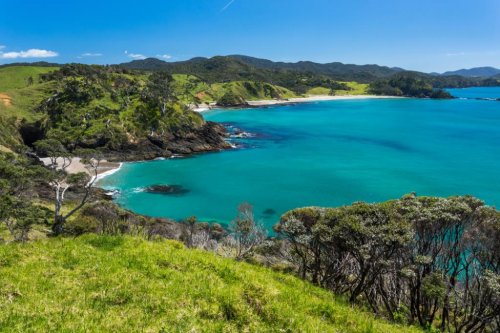
Sights
like this abound in the Bay of Islands

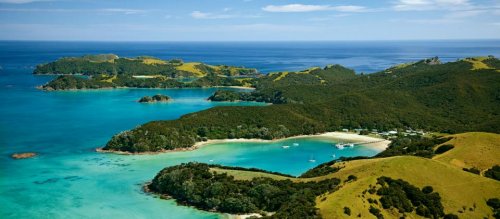
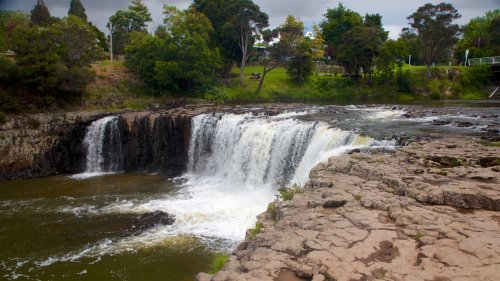
Haruru
Falls |
|
|
| |
|
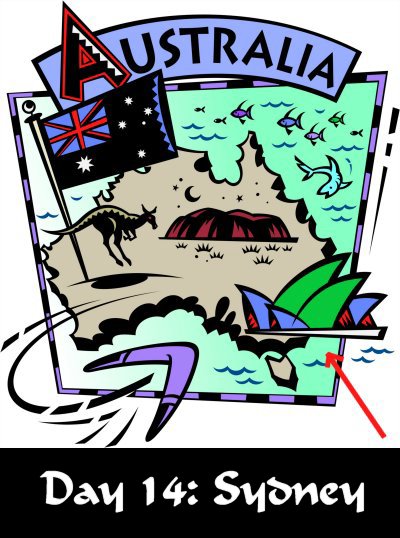 |
Following our
visit to the Bay of Islands, the time has come for the two
day journey back to Sydney, Australia. This is the
perfect time to finally get some rest.
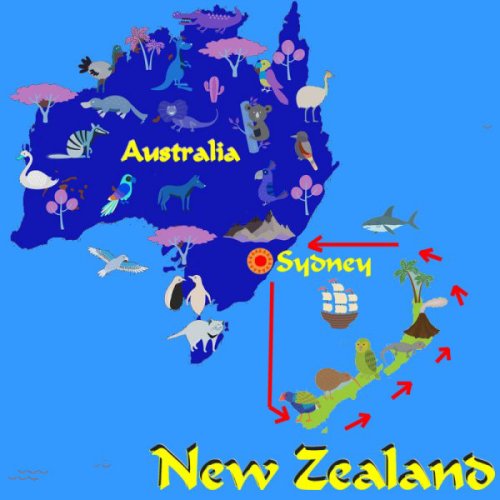
|
|
Royal Caribbean's
Ovation of the Seas
Ovation of the Seas is a Quantum Class ship
entered into service in 2016. A non-stop fun ship filled
with loads of bells and whistles--Rip Cord I Fly, North Star
Capsule, Bumper Cars, Club Two70, a Bionic Bar plus all of
our expected venues.
The ship's entertainment scene is outstanding, with
Broadway-style shows and cabarets that combine human talent
with technical wizardry. All-singing, all-dancing gadgets
are not just confined to the stage. Ovation
has myriad high-tech features including Royal IQ, a free
interactive scheduling service that lets passengers make
reservations for dining, entertainment and activities; it's
available as an app for mobile devices or can be used via
kiosks and tablets throughout the ship. Thanks to a huge
investment in satellite Internet, connectivity is fast and
efficient. It's good to see USB ports for in-cabin charging
and the option for RFID WOWband wristbands, which can be
used instead of key cards.
North Star: The exclusive North Star promises to elevate you
both physically and emotionally, revealing 360-degree views
of a world you've truly never seen before! Simply step into
the intimate, jewel-shaped capsule, and gently ascend over
300 feet above sea level, where you can take in breathtaking
views of the ocean, the ship, and the exciting destinations
that we visit.
Rip Cord IFly: Experience the exhilaration of skydiving
without ever leaving the deck, courtesy of RipCord by iFLY.
Feel what it's like to fly, as you float on air within the
safe confines of this groundbreaking simulator. It's a whole
new thrill for thrill seekers of all kinds.
Bumper Cars: SeaPlex, the largest indoor amusement activity
space at sea. You can get down on the roller rink or run
away to circus school. And the first-ever bumper cars at sea
onboard, so you can bump your game like never before.
Club Two70: This is one venue you have to see to believe.
Day to night, Two70 presents immersive scenery on a 270°,
floor-to-ceiling wall of windows. From ocean views to a
lively undersea scene to surreal vistas, grab a drink and
start gazing because you never know what you'll see. In the
evening, it's a place that can take you anyplace, where live
entertainment pairs with an amazing multimedia event. When
evening turns to night, Two70 transforms turns into a
nightclub like no other. And during it all the hand-crafted
cocktails are flowing at Two70 Bar.
Bionic Bar: Meet two robotic bartenders who know how to
shake up your night out. They can mix, muddle, and stir it
up too. With moves as fluid as the Pimm's in your cup, they
can create an almost endless combination of cocktails,
whether it's a classic Manhattan or a custom order of your
own design. Just order by app on the nearby tablets and
watch your bionic mixologist do its thing. Designed and
powered by the minds at Makr Shakr, the Bionic Bar® is
making history at sea.
|
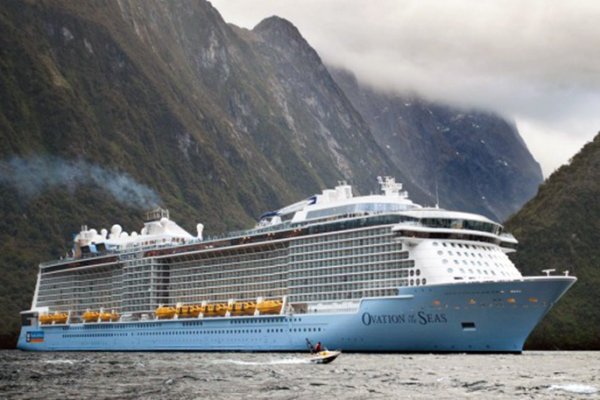
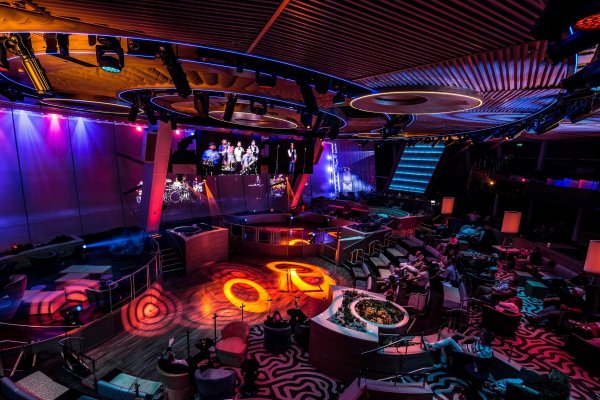
Club Two70
Dance Floor
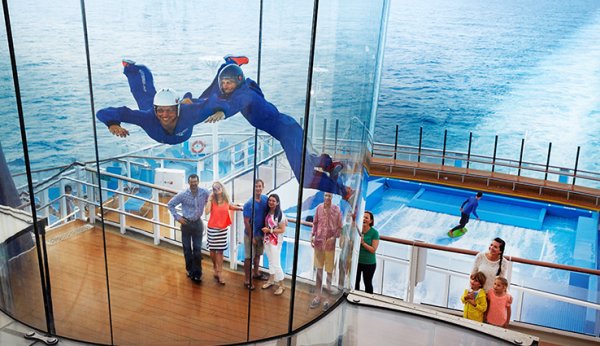
Rip Cord
I-FLY |
|
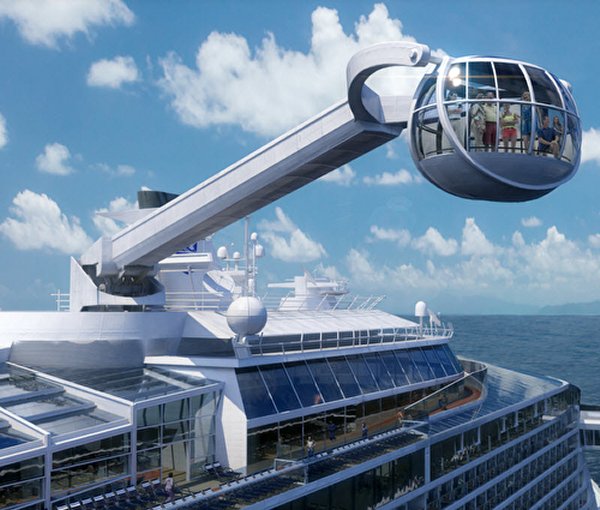
North Star |
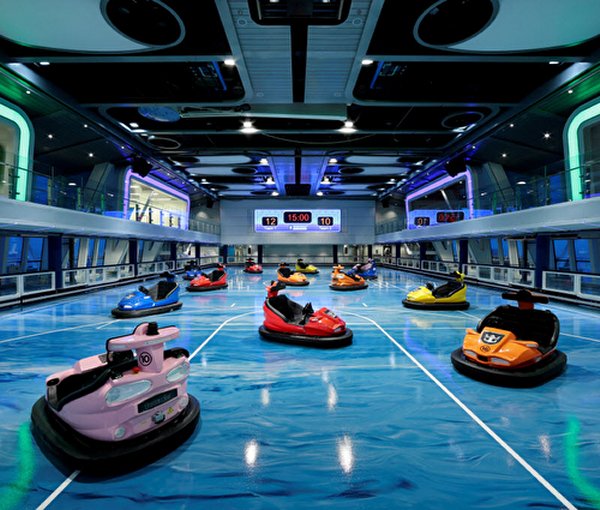
Bumper
Cars |
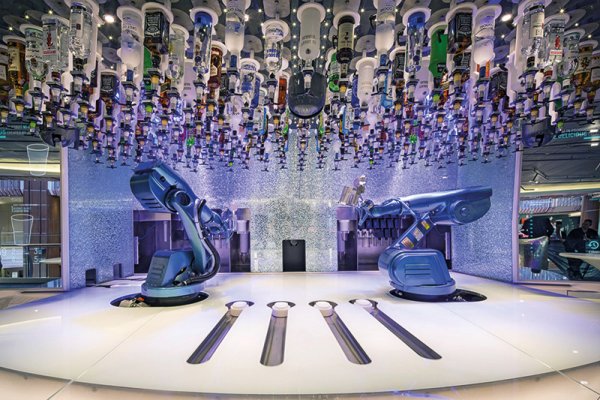
Bionic Bar |
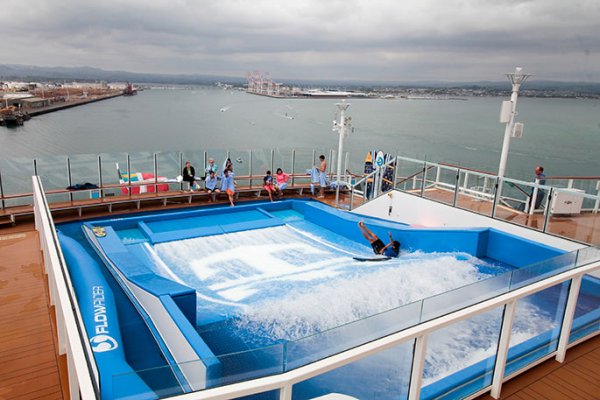
Flowrider |
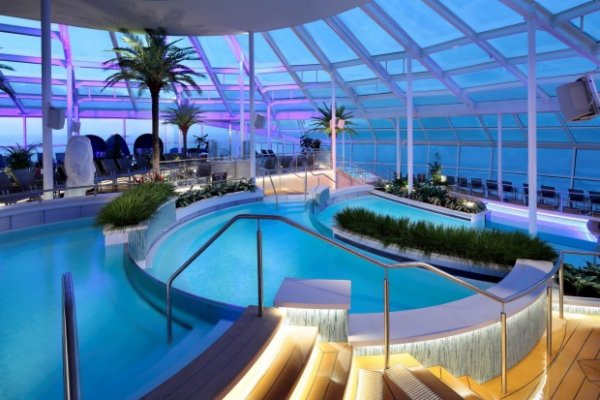
Solarium |
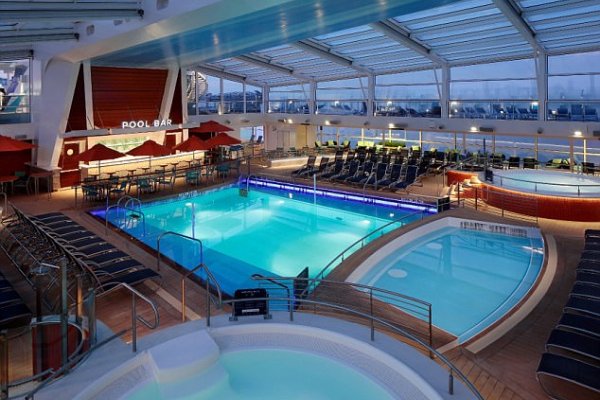
Pool Area |
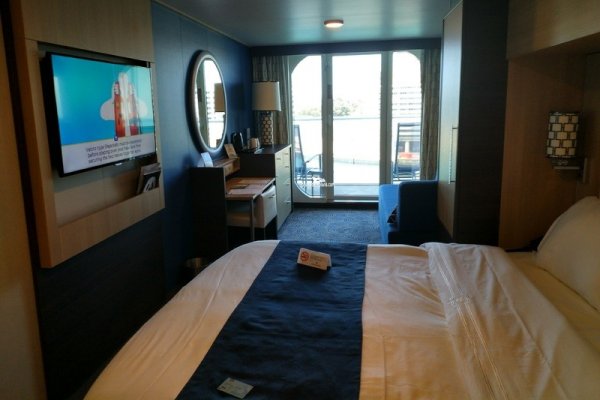
Balcony
Stateroom |
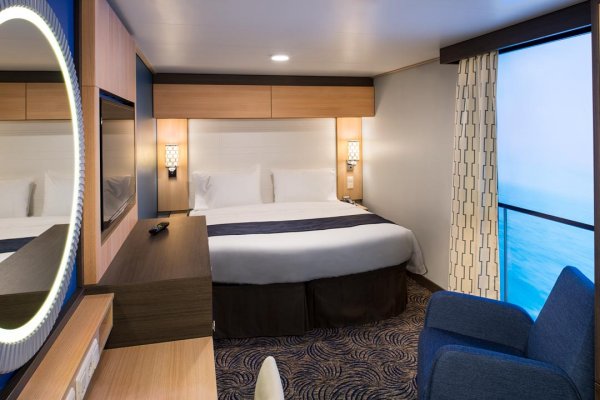
'Virtual
Balcony' Inside Stateroom |
Marla's Notes:
Royal Caribbean
Cancellation Charges:
1. UNTIL DECEMBER 8TH,
2018 -- NONE
2. DECEMBER 9TH, 2018 -
JANUARY 10TH, 2019- $450 PER GUEST
DEPOSIT
3. JANUARY 11TH, 2019 - FEBRUARY
7TH, 2019 -- 50% OF TOTAL
FARE
4. FEBRUARY 8TH - FEBRUARY 21ST,
2019 -- 75% OF TOTAL FARE
5. FEBRUARY 22ND ONWARD -- 100%
SSQQ Travel Service Charges:
1. $50 Charge for any Change
2. $100 Per Person for cancellation of trip
Marla Archer
"SSQQ Travel"/West University Travel
713 862-4428 (direct line)
|
|
|
|
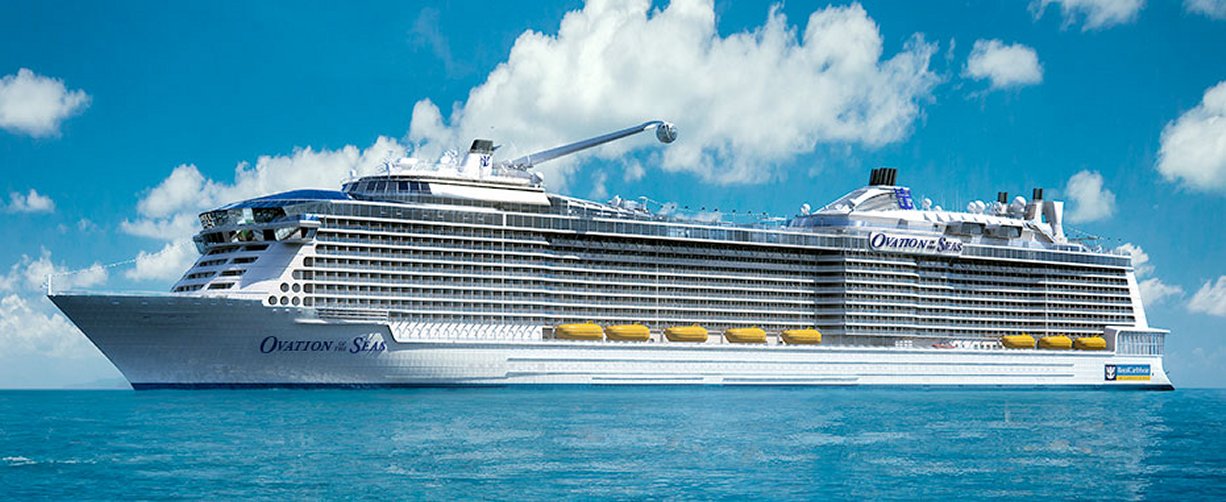
The Great New Zealand Trivia Quiz
Rick Archer's Note:
One of the joys of traveling is the chance to learn some
more about areas of the world we did not know much about. I
would guess that of all locations on earth, we know the
least about Africa.
After Africa I suppose it is a toss-up between Asia and
Oceania. I bet most of you do not know a darn thing about
New Zealand. I have prepared a little quiz for you.
Let's see if you are any good.
RICK'S NEW ZEALAND TRIVIA QUIZ
1. What famous movie was filmed in New Zealand?
Lord of the Rings (if you didn't
get this one, quit now)
Game of Thrones
South Pacific
Godzilla
King Kong
Battle of Iwo Jima
2. Which European first discovered New Zealand?
Abel Tasman (Mr. Tasmania, 1648)
James Cook
Amerigo Vespucci
Ferdinand Magellan
Posh Spice
3. Which is closest to the Arctic Circle?
Australia
South Africa
Russia (Arctic Circle, trick
question. Did you get it?)
Argentina
New Zealand
4. The first people of New Zealand were known as:
Aborigine
Zulu
Maori
Kiwi
Scottish
Polynesian
Aucklander
Martians
5. How far is New Zealand from Australia?
200 miles
800 miles
1,200 miles
2,000 miles
3,000 miles
6. New Zealand is comprised of:
600 islands
One main island
Two main islands
Three main islands
Seven main islands
7. New Zealand is closest to:
Tahiti
Galapagos
Hawaii
Philippines
Fiji
Australia
8. Which is not an island just off the coast of New Zealand?
Chatham Island
Pitcairn Island
Stewart Island
Auckland Island
Great Barrier Island
9. The tallest mountain in New Zealand is
Mt Victoria
Mt Elizabeth
Ayers Rock
Mt Cook
Mt Krakatoa
10. The capital of New Zealand is:
Wellington
Dunedin
Auckland
Melbourne
Sydney
11. What do Norway and New Zealand have in common?
Deep oil reserves
Proximity to the Poles (no, not Poland, dummy)
Great skiing
Fjords
High Quality of Living Index
12. Which island is not a neighbor of New Zealand?
New Caledonia
Falklands
Tahiti
Samoa
Tonga
Fiji
13. Which celebrity is not from New Zealand?
Keith Urban
Russell Crowe
Lorde
Peter Jackson
Hugh Jackman
Lucy Lawless
14. New Zealand is famous for what sport?
Cricket
Soccer
Skiing
Rugby
Australian rules football
15. What is the most unusual feature of Auckland?
below sea level
located on isthmus (Answer to
Trivia Question: Seattle, Washington)
located on peninsula
main part developed inside extinct volcano
located on archipelago
16. What is the favorite dance of New Zealand?
The Scottish Reel
Thriller
Waltzing Matilda
Haka
Jive
17. If you sail due east from New Zealand, the next
landmass you will reach is:
Tahiti
Samoa
Indonesia
Galapagos
Argentina
Hawaii
|
From: Tom Holthe
Sent: Wednesday, February 28, 2018 12:24 PM
To: Rick Archer
Subject: Erroneous answer to New Zealand
Quiz
Something to ponder. Regarding
question 17 in your New Zealand quiz, you do not run into
Tahiti if you travel east of New Zealand, you hit Chile
(which is not one of your options) Please see attached
picture.
Rick's Reply:
I spent all of 30 seconds making up that question using
Google Earth and I daresay I forgot
the Earth is curved.
Small mistake.
Had the Earth been flat, I would
have been correct. Furthermore,
I doubt seriously that anyone BUT
YOU cares. That said,
I am forced to admit
I have made my first Geography error in
the past 30 years. For your troubles, I will buy you a
beer on the trip. ;-)
|
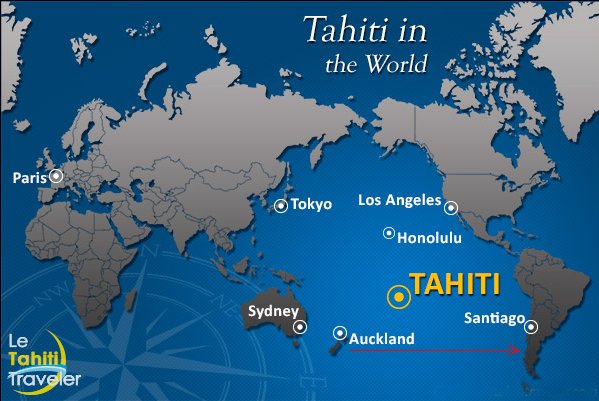 |
| |
A Note about the Australia-New Zealand
Trip from Margaret Easley
From:
Margaret Easley
Sent: Saturday, February 24, 2018 4:12 PM
To: Marla
Subject: Marla's 2019 Cruise
trip to New Zealand and Australia
Hi Marla!
Just read your newsletter and it brought back great memories
of Australia and New Zealand. You haven't asked for tips on
what to do but being the travel agent without clients that I
am, I decided to put in my two cents anyway!
Australia
We had a wonderful time in Sydney! Definitely our favorite
city that we saw in Australia! Probably you can't get a good
condo now, but we loved the condos we stayed in! Roomy, A/C,
and most importantly a washer and dryer in the condo! The
subway system is awesome - you can basically get anywhere on
the train and if you can't get there by train you can use
the tram or ferry. All of them take the oyster card. Now for
the highlights of our Sydney stay:
1. Climb the harbor bridge! Do the most popular (I think)
which is the climb over the top arch. I am definitely afraid
of heights but managed to do this without a lot of drama.
Just the sense of accomplishment for me was a major high not
to mention the views!
2. We greatly enjoyed both the ferry to Manly Beach (and the
beach itself was awesome) and the zoo. The gorillas were the
most entertaining animals I have ever seen with the
"toddler" really showing out and turning somersaults for us
and rushing the window and banging on it. Koala exhibit -
yawn. Much better one at a wildlife park on the way to the
Blue Mountains.
3. Blue Mountains were very pretty but it is an all day trip
and basically is a smaller grand canyon with trees. Wouldn't
be first on my list, but if the tour includes the wildlife
park, then maybe.
4. Our favorite restaurant was the Sydney Haufbrau House
which is right down the street from the pier. It is very
easy to get around Sydney. Circular Quay (the subway
station) is right down from the pier where you will dock.
The ferries are also there. To get to this restaurant, you
just cross the busy street in front of the pier and walk up
the hill. If it is a weekend, there will probably be a
street fair going on since part of this is a pedestrian
mall. The Hauffbrau house is at the top of the hill on the
corner of the pedestrian mall. They have a good happy hour
and live german music. We loved to share the Weiner
Schnitzel but I know Rick is a Vegetarian. Also great
pretzels.
5. There is an old hotel called the Australian Heritage
Hotel up the hill from the pedestrian mall. I think it is on
York Street. I can't find my journal but I think this is the
name. Just ask any native where the old hotel is that sells
coat of arms pizza. Again, this is something you would have
to enjoy yourself since one side has Kangaroo and the other
side has Emu. These are the two animals on the Australian
coat of arms. Delicious and not too expensive according to
Sydney prices! They also have a happy hour.
6. There is a free walking tour of Sydney that begins at 10
AM that would be very beneficial the first day or so to
learn the layout of the city. Just google free walking tour
Sydney.
So many things to do in this great city! Prices for food are
outrageous! China town is close to the main subway station
and that is where we stayed the longest. Just around the
corner from our condo was the main street of china town and
they had some pretty good restaurants and one little window
where you can get great little "donut holes" (can't remember
what they called them - they were basically little cream
puffs) at a very reasonable price. You can't miss it because
there is always a long line out into the street, but the
line goes quickly.
New Zealand
We had bad weather all through our New Zealand cruise. Hope
you are luckier! The seas were so rough that even though
they had a wonderful dance venue and teachers, we didn't get
to dance until the latter part of our 12 day cruise.
None of the tours we went on were much to write home about -
again the weather made this less fun since it was very cold
and rainy. However, the big highlight of this cruise was the
little tour I found that let you swim with the tiny wild
dolphins in the bay! Definitely one of our most enjoyable
experiences! The tour group was called ecotours and they
were fabulous. Started out very spartan. They had a tiny
trailer at the pier with one wooden bench and some hooks foe
the women to get changed into their wet suits. The lucky
guys got to strip down outside in 48 degree weather with
spits of rain and gale force winds. Certainly not an
auspicious beginning. I was not happy. However, the suits
turned out to be very warm and after that things got really
good. The swells were about 5 meters that day, but the
dolphins were everywhere and we got to swim with them
darting all around for a good hour. Then back on our little
boat to see penguins and sea lions while drinking hot
chocolate and eating ginger cookies (which settled my queasy
stomach - the swells were making me turn green). All in all
a very wonderful day for a reasonable price - $165 each.
OK. I'll stop. Whatever you do, I know you'll have a
wonderful time. Sydney ranks up there with London and
Barcelona for me and Tom.
Safe travels!
Margaret
|
|
|